5.1.1 Lost in the Delta Quadrant
5.1.2 Starting points
While Voyager's journey through the Delta Quadrant was considerably better documented than for instance the subdivision of the Galaxy or the structure of the Federation at the beginning, and was more simple and logical than many other parts of the Star Trek Cartography, in the meantime this journey have rather complicated due to numerous continuity problems, contradictions, but also new basis information. The latter fact has lead to the problem that concerning Voyager's journey, one cannot simply use 1000 ly/year regularly travel distance per year plus the leaps made in the course of the seven year journey any longer. How Rick Sternbach, the "keeper" of the official route of Voyager (that we unfortunately will not know exactly until the ST:VOY TM is published) recently remarked correctly, the distance of Sol to the Galactic core, the initial distance of Voyager from Earth and her bearing are decisive for a depiction of Voyager's journey. A further cornerstone of the Voyager cartography is also Voyager's average speed which has been officially fixed recently. However, the problem arises that all these "fixed values" aren't that fixed in the end. This even applies to the distance of Earth from the center of the Galaxy. Yet, I tried to use the most recent and least contradictious values.
5.1.3 Overview of the journey
5.1.4 Calculation of the momentary distance
While the above table of course only shows Voyager's distance to Earth for selected key events, it is also possible to determine a precise distance at any time by not deducting the yearly covered distance abruptly at the end of each year, but distributing it equally over the whole year. We then get the momentary distance by deducting the already travelled percentage of the yearly covered distance from the appropriate table distance before the given stardate
For the calculation of Voyager's distance to Earth at a particular time (and therefore the distance of the regions of space crossed and the planets visited at this time etc.), you can use the following step-by-step instructions.
1. Look up the stardate of the episode, e.g. in the ST:VOY Guide .
Example: For [VOY] Message in a Bottle Stardate 51461.5
2. Choose a reference distance to Earth from the above table by comparing the stardate with the table stardates. Important: You have to ignore all yearly covered distances (Stardate xx0000-xx999)!
Example: Stardate 51461.5 is bigger than 51268 in 6., but smaller than 51978 in 8.; the reference distance to Earth is therefore 62134 ly.
3. Beside the now following normal deduction of the percentage of the yearly covered distance (1), 2 special cases have to be considered: (2) in the first year (stardate 48317-48999), Voyager only travelled 300 ly, therefore the yearly distance being accordingly smaller, and (3) between stardate 51008 and 52619, a Borg correction factor has to bee added to the distance, because during this period of time, Voyager's journey became 2 years longer because of avoiding Borg space.
Example: Stardate 51461.5 is between 51008 and 52619, thus variant (2) has to be used. Enter the stardate and reference distance 62134 ly at (2) and click on the button to calculate the momentary distance of Voyager from Earth at this time.
With the locations of Voyager's journey and a possibility to calculate her exact positions, we also know the positions of all planets visited by Voyager and the territories crossed by the ship. Consequently, the "official" Delta Quadrant is paradoxically much better known than the Alpha or Beta quadrants. Therefore, the following passages deal with the significant locations of the journey of the USS Voyager. Finally, at the end of the chapter a short prospect for the further course of the still continuing journey will be given.
5.1.5 The first year
Since the USS Voyager was taken to the Delta Quadrant by the Caretaker not before stardate 48317 (that is in April 2371), the first "year" of Voyager's journey covers only 683 stardate units or 249 days. Consequently, at an average speed of warp 6.2 (438c), Voyager can only travel 300 ly out of the usual 438 ly in 2371. With such a short annual distance, the galactic surroundings has to remain the same to a large extent during this first year - and indeed, Voyager stays the entire year in the sphere of influence of the Kazon-Ogla, Vidiians and Talaxians, who they contacted already in the first weeks in the Delta Quadrant.
5.1.6 The second year
During the second year of her journey, Voyager seems to get on as slowly as in the first year, still passing colonies of the Talaxians, Vidiians and Kazons (mainly Ogla and Nistrim, but also other sects). The reason for this congruence are the diverse delays and course deviations due to the fights with the Kazons, which make a lower speed than the average warp 6.2 and therefore a annual distance of less than 438 ly plausible. However, there were further events in this year that delayed the voyage home, what is proven by the following example
Involuntary "shore leave"
Only after six weeks, during which Voyager kept on flying with normal speed and, according to Tuvok, covered 70 ly in this time, what corresponds to an average speed of warp 6.8 , Voyager has the opportunity to get a cure from the Vidiians. Although Tuvok set a speed of warp 6 after they escaped the Vidiian trap, it is unlikely that Voyager stayed at that speed for the whole time of the flight back to the planet, because then they would have needed a longer time than for the outward flight. Therefore, we can assume that it took Voyager between 3 weeks (at warp 8) and 5 weeks (at warp 7) to travel back to "New Earth". Using the first, more optimistic figure, the crew therefore loses 80 d all in all, what corresponds to a annual distance shortened by 95.998 ly at an average speed of warp 6.2. At the end of the episode, Captain Janeway resumed the course home at warp 8 in order to make up the lost time, but is this possible at all? Day 24 of the involuntary "shore leave" (probably counted without the 17d stasis) corresponds to stardate 49690.1 according to the episode, what places the resumption of the voyage home on stardate 49892.7 . In the remaining 107.3 stardate units or 39.1645d, Voyager could have indeed make up the lost distance of 95.998 ly with an average speed of nearly warp 8 ( warp 7.684 ) , and with an average speed of somewhat more than warp 8 ( Warp 8.66 ), she could additionally travelled the rest of the annual distance of 46.9974 ly that has still to be managed in the remaining time.
During her journey without captain and first officer, the crew has contact to the Vidiians for the last time, therefore Voyager definitely leaves the sphere of influence of this species. Provided that Voyager made first contact with the Vidiians on stardate 48532.4, their territory seems to cover at least 535 ly , although a large extension "above" Voyager's position at the time of first contact is not impossible.
5.1.7 The third year
Despite no large leaps and the usual annual distance of 438 ly, the third year is a year of changes for Voyager's journey. After two years, she finally leaves the known space populated by the Kazons and Vidiians and ventures to new, unknown regions of the Delta Quadrant.
Leaving Kazon space
Already just at the beginning of the year, on stardate 50032.7, the crew of Voyager has the last contact with the Kazon, what seems to imply that they finally leave their "territory" (better called the space dominated by the - nomadic - Kazon sects). It is unknown how far Kazon space extends "above" the Ocampa homeworld, where first contact were made by the crew of Voyager on stardate 48317. However, this planets seems to be located in the border zone rather than in the center of their space, which is dominated by more powerful sects than the Kazon-Ogla, for instance the Kazon-Nistrim. Regarding the space crossed by Voyager within the last 2 years (since the arrival in the Delta Quadrant on stardate 48317), this leads to a diameter of about 750 ly , what can be considerably less (using a lower annual average speed of Voyager in the first year) or more (based on the assumption that Kazon space extends over several hundred light years above the Ocampa homeworld. A diameter of this magnitude seems to be plausible in view of the fact that the Kazon, being nomadic living traders and conquerors, must naturally populate a larger region of space, what necessarily means that every single planet within this territory must be in their hands, but that the region can have larger "gaps". At any rate, these extensions of the influence spheres of the Vidiians and Kazons support the low annual average speed of 6.2, since based on the maximum cruising speed of Voyager (warp 8 = 1000c), the territories of this rather insignificant species would cover 1500-2000 ly.
The Barzan Wormhole
The territory of the Swarm
The Nekrit Expanse
The Nekrit Expanse is described as an extensive, not surveyed, instable region of space which is full of interstellar dust clouds and plasma storms, but contains only few planets. The expanse has a width of several thousand light years , but seems to be not very deep since Voyager can cross the region in relatively short time. She enters the Nekrit Expanse in "Fair Trade" and apparently already leaves it sometime between "Unity" and "The Darkling", because in the first episode, the expanse is explicitly mentioned (and shown), while in the latter one, with the arrival at the Mikhal outpost Voyager enters a completely new, unknown region of space, and the expanse does not play any part in the following episodes. Consequently, Voyager was definitely inside the Nekrit Expanse between stardate 50443 and 50654 - what results in a total time of 211 stardate units or 77d . If Voyager travelled only at an average speed of warp 6.2 during this two and a half months, then the expanse has a depth of 92.398 ly . However, it is more likely that Voyager travelled at a considerably faster speed during that time. In "Fair Trade", it was mentioned that there are only few planets within the expanse and Voyager loads all necessary supplies for the journey in this episode so that regular stops aren't necessary in the end. This assumption is confirmed by the small number of missions while they travelled through the expanse (visit of four planets). Therefore using the maximum cruising speed of Voyager - warp 8, we get a depth of 216.017 ly for the Nekrit Expanse, a figure, that is considerably more plausible in view of the large width and the ignorance of the people in the regions explored by the USS Voyager about the space behind the expanse. Based on a constant cruising speed of warp 8 and the stardates of the single episodes we can now calculate the distances of the visited planets and crossed regions within the Nekrit Expanse from the border of the expanse:
5.1.8 The forth year
The Mutara class nebula
Note : Because of the incorrect stardate calculation (2.7 days / unit instead of the correct 2.7 units / day) this episode overlaps with the next one, [VOY] Hope and Fear.
5.11 Conclusions
Summarizing, most episodes seem to confirm the calculated route of Voyager. However, there are countless possible variants that would roughly match with the distances given in the episodes. Surely the ST:VOY Technical Manual - should it ever be published - will show a completely other picture of the journey, but until then, the depicted table is as exact and "canon" as possible in view of the many variables that have to be taken into consideration and the many discrepancies and errors in the show itself. Concluding, the following table lists some of the congruences as well as the discrepancies of the calculated route and the actual distances mentioned in the series.
In the end, the last leap on stardate 53329 and the distance Voyager has bridge since then results in a distance of 30067 ly to Earth in the middle of season 7 (by stardate 54500), if the already covered part of the annual distance (219 of 438 ly) is included in the calculations. Consequently, at this time Voyager is only 1944 ly away from the border of the Delta Quadrant, using the revised distance of Earth from the Galactic core (25,800 ly). Hence, she will probably never reach the Beta Quadrant, which is inexplicably a taboo in Star Trek: Voyager, but will surely directly travel back to Earth (by slipstream, transwarp or whatever propulsion technology or powerful being) by the end of season 7, if the "policy of small leaps" of the recent episodes is kept up.
� 1999-2001 by Star Trek Dimension / Webmaster . Last update: February 14th, 2001

Memory Beta, non-canon Star Trek Wiki
A friendly reminder regarding spoilers ! At present the expanded Trek universe is in a period of major upheaval with the continuations of Discovery and Prodigy , the advent of new eras in gaming with the Star Trek Adventures RPG , Star Trek: Infinite and Star Trek Online , as well as other post-57th Anniversary publications such as the ongoing IDW Star Trek comic and spin-off Star Trek: Defiant . Therefore, please be courteous to other users who may not be aware of current developments by using the {{ spoiler }}, {{ spoilers }} OR {{ majorspoiler }} tags when adding new information from sources less than six months old (even if it is minor info). Also, please do not include details in the summary bar when editing pages and do not anticipate making additions relating to sources not yet in release. THANK YOU
- Memory Beta articles sourced from reference works
- Memory Beta articles sourced from novelizations
- Memory Beta articles sourced from short stories
- Memory Beta articles sourced from comics
- Astronomical regions
- Milky Way Galaxy
Delta Quadrant
- View history
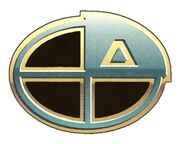
Locator logo insignia showing the galaxy 's Delta Quadrant .
The Delta Quadrant is one of the four quadrants of the Milky Way Galaxy , and is home to many alien races and cultures , most notably the Borg Collective . ( TNG episode : " The Price "; DS9 episode : " Q-Less ", Star Trek: Voyager )
- 1.2 History
- 1.3 Kelvin timeline
- 1.4 Scientific phenomena
- 1.5 Sectors
- 1.6 Stars and systems
- 1.7 Planets and planetoids
- 1.8 Races and cultures
- 2.1 Connections
- 2.2 References
- 2.3 External links
History and specifics [ ]
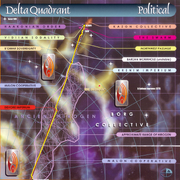
Star map of the Delta Quadrant.
The members of the Confederacy of the Worlds of the First Quadrant refer to the quadrant as the First Quadrant . ( VOY novel : Acts of Contrition )
The Delta Quadrant comprises one quarter of the galaxy , with major extensions of several spiral arms making up its environs, including major portions of the 3 KPC , Norma and Crux Arms , as well as trailing sections of the Carina and Orion Arms and a small portion of the base of the Sagittarius Arm . ( ST reference : Star Charts )
History [ ]
The Delta Quadrant represented an incredibly remote frontier to the Federation and other Alpha Quadrant races and cultures in the 23rd and 24th centuries . The romance of this concept led to a bar named after the Delta Quadrant in an alternate reality of the 2250s . ( TOS - Starfleet Academy novel : The Delta Anomaly )
The first known Humans to explore the Delta Quadrant was the Hansen family in 2354 , when they followed a Borg cube through a transwarp conduit . Unfortunately, Magnus and Erin Hansen could not bring back any data on the unexplored region, as they were assimilated in 2356 . ( VOY episode : " The Raven ")
An expedition to explore the far side of the Barzan wormhole led a shuttlecraft commanded by Lieutenant Commanders Data and Geordi La Forge to the Delta Quadrant. However, the wormhole was expected to lead to the Gamma Quadrant and was found to be unstable. The two officers managed to return safely. ( TNG episode : " The Price "; VOY episode : " False Profits ")
In 2369 , Q offered to take Vash to the Delta Quadrant if she continued her adventures with him. Vash declined the offer. ( DS9 episode : " Q-Less ")
In 2371 , the Federation starship USS Equinox was catapulted to the Delta Quadrant by the Caretaker , a representative of the Nacene . Later that year, the Caretaker pulled the USS Voyager into the distant region. After becoming stranded, Voyager spent seven years travelling through the quadrant, before returning to the Earth in 2377 . ( VOY episode & novelization : Caretaker , VOY novelization : Equinox , VOY episode : " Endgame ")
Due to limited expeditions into the distant quadrant, the Federation knew very little about it until 2374 , when Voyager made contact with Starfleet . Since Voyager 's return, the Federation's knowledge of the Delta Quadrant has increased considerably. ( VOY episode : " Message in a Bottle "; VOY episode & novelization : Endgame )
Voyager was fitted with a quantum slipstream drive and assigned to Project Full Circle , a Starfleet expeditionary force sent to explore the Delta Quadrant. ( VOY novel : Full Circle )
In 2568 , when Prefect Tamar of the Kelvan Armada arrived in the Milky Way Galaxy to check on Rojan 's advanced team, he expected them to have seized control of the most of the galaxy, and be advancing into the Delta Quadrant after 300 years. ( TOS - Strange New Worlds 9 short story : " Gone Native ")
Kelvin timeline [ ]
In 2262 of the Kelvin timeline , the USS Enterprise under Captain James T. Kirk became stranded in the Delta Quadrant for a month. There, they encountered Eurydice of Hexel VII . She then brought the Enterprise to the Dark Market , where she gave them to the Market's Syndicate in exchange for her daughter. However, Kirk was able to escape and the Enterprise was able to return to the far edges of the Alpha Quadrant . ( TOS - Eurydice comics : " Part 1 ", " Part 2 ", " Part 3 ")
Scientific phenomena [ ]
The Delta Quadrant houses a sector of space devoid of star systems for at least 2,500 light-years . The crew of the USS Voyager nicknamed this area of space the Void . As the ship journeyed through, they encountered a species native to the area known only to the Voyager crew as the Night Alien . ( VOY episode : " Night ")
Underspace was a vast network of subspace corridors which allowed traveling up to two-hundred light years possible within five minutes. It was said the corridor likely spread the entire Delta Quadrant. A ship could only access Underspace if the ship passing through had its warp field modulated at the correct frequency to interact with the corridor. ( VOY episode : " Dragon's Teeth ")
Kelemane 's planet was a planet in the Delta Quadrant which contained a tachyon core, which generated a subspace particle field . Due to the generation of the particle field, the planet rotated 58 times a minute, translating to a day occurring every 1.03 seconds outside of the field. On the surface of the planet, the native species was unaware of these circumstances. ( VOY episode : " Blink of an Eye ")
Sectors [ ]
Stars and systems [ ], planets and planetoids [ ], races and cultures [ ], appendices [ ], connections [ ], references [ ].
- TNG episode : " The Price "
- VOY episode : " Caretaker ", etc.
- PIC novel : Firewall
External links [ ]
- Delta Quadrant article at Memory Alpha , the wiki for canon Star Trek .
- Delta Quadrant article at STO Wiki , the FANDOM wiki for Star Trek Online .
- Delta Quadrant article at Star Trek Expanded Universe wiki , the wiki for fan-authored Star Trek .
- 1 The Chase
- 2 Preserver (race)
- 3 Totality (Andromeda)
Brilliant Maps
Making Sense Of The World, One Map At A Time
Star Trek Map Of The Alpha & Beta Quadrants
The map above is Shakaar’s Alpha/Beta map v3.3; a fan-made creation showing the Alpha and Beta quadrants of the Star Trek universe.
The map shows both major and minor powers that have appeared in the various series over the years.
At the centre is the United Federation of Planets, which borders the major power of the Klingon Empire, Roman Star Empire and the Cardassian Union. More minor powers include the Breen, Ferengi Alliance, Tholian Assembly, Sheliak Corporate and the Gorn Hegemony among many, many others.
The map highlights:
- Principal Systems
- Minor Systems
- Non-Aligned Systems
- Dead Systems
- Government Borders
- Points of Interest
- Navigation Hazards
- Star Clusters
- Stations or Starbases
For more Star Trek maps see:
- Star Trek Stellar Cartography: The Starfleet Reference Library
- Star Trek Star Charts: The Complete Atlas of Star Trek
- Star Trek Maps
Enjoy this map? Please help us by sharing it:
Get Our Latest Brilliant Maps Weekly:
Other popular maps.

European Capitals By Coats of Arms (City Emblems)
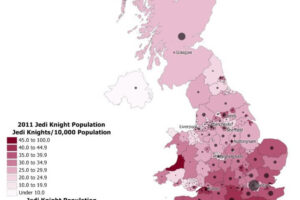
Jedi Knight Population Of The UK
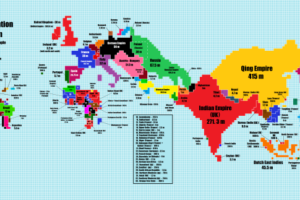
The World’s Population In 1900 Looked Very Different Than Today
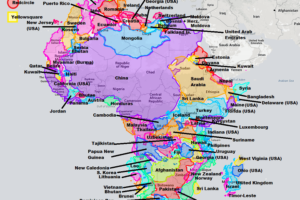
The True Size of Africa
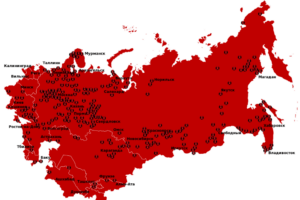
Map of The Soviet Gulag Archipelago 1923-1961

Jewish Population of Europe in 1933 and 2015

Potential EU Exit Names For The 27 Remaining Member Countries

Hilariously Bad Attempts By Americans to Draw Europe From Memory, With an Unexpected Twist
December 13, 2017 at 8:14 pm
I know that: a) it’s a bit of fun b) it’s hard to make a 2d map of 3d space and c) there no official maps to go off
But Christ, there’s a lot of stuff on here which makes no sense.
Justin Spaulding says
September 7, 2019 at 2:36 am
Isn’t gamma haromi 2 supposed to be in the haromi cluster…. Good effort though! S3. E8 I think. The “gatherers”
Danny Beans says
November 11, 2019 at 11:18 pm
Why are Ceti Alpha V and Ceti Alpha VI in completely different sectors? I mean, okay, Chekov can be a little dumb sometimes, but that’s one helluva mistake to make.
Jadziah Dax says
April 7, 2021 at 6:03 pm
Can’t wait to see the one you do!
petewinsemiusyahoocom says
November 23, 2022 at 3:47 pm
I agree, several planets said to be in the alpha quadrant are in the beta quadrant and vice versa or not listed at all.
Resolute_Phoenix says
February 8, 2018 at 11:41 pm
Okay so Xindus by Vulcan…. kys I’m not even gona bother looking further don’t make a map if you don’t know what your talking about
February 18, 2019 at 9:03 pm
Romulons should have Dyson sphere (at least at Romulus and Remus). Their ship tech is based on creating black holes which will give a ship a reactor core with a life of a handful of years BUT it’s just like an inefficient battery because it takes way more energy to initially create it then it will give off over its life BUT it’s portable. Sure beats light sails if your depending on home system energy and way more flexible too. This was their tech wheelhouse, and was their interstellar travel energy source instead of antimatter. It makes total sense for them to have harnessed the majority of their native suns energy to create reactor cores wherever they needed a portable energy that couldn’t tap into the system wide grid.
February 22, 2019 at 9:26 pm
A few questions… 1) Why are there several Indus VIII on the map?, 2) I do not see the First Federation on this map — they should be near the Ferengi!, 3) Where is the Kelvin planet? (The planet colonized by the Kelvins from “By Any Other Name”), 4) Maybe I’m wrong, but I do not see the Dyson Sphere that TNG crew ran into?
Shane Montgomery says
March 4, 2020 at 10:25 pm
I don’t see Barzan II or the Barzan Wormhole here?
Pickard says
January 23, 2021 at 3:39 pm
They are there. Literally the only Dyson sphere symbol near the bottom.
August 6, 2019 at 5:03 pm
Spock: He is intelligent, but not experienced. His pattern indicates two dimensional thinking.
Glenn Bryson says
November 15, 2019 at 6:52 pm
Not your fault, I know;
Vulcan is “Supposed” to be “A little over sixteen” light years from earth. Yet the map has it at around 1000. That’s one of my biggest gripes about Star Trek (I absolutely love Star Trek, don’t get me wrong). Distances and travel times are so inconsistent and unrealistic based on the documented scales, maps, etc.
March 14, 2020 at 11:46 pm
Did you mean Starbase 375 instead of 395? As in the starbase from S6 of DS9 after the Dominion took over the station?
Avro Arrow says
March 24, 2020 at 7:04 pm
I love this map, especially how you have the Hydran Kingdom, the Lyran Star Empire and the Kzinti Hegemony are listed (where is the Interstellar Concordium?). I have one small nit-pick to make and that is you have two systems named “Nelvana III”. They’re both in the upspin Beta quadrant but one is in the Romulan Neutral Zone and the other is further upspin and outward (left). I think that you might consider making most of the empty space that is coreward of Klingon and Romulan space into the ISC. They were referred to as being a Galactic Superpower residing on the far side of both those Empires (so, coreward).
Gray.Elton says
May 19, 2020 at 3:21 am
If we do or don’t do it, someone will laugh
July 15, 2020 at 1:53 am
I dont understand how this can be called a map of the star trek galaxy when there isnt even a spot or indication of where earth is. Who makes a map without earth when you have a series where its location is based on earth. In the series they refer to Earth as Earth. Yet the closes thing to it is on the map is Volcan. Y not add Earth as well? If there is an alternative name how come it’s never mentioned in the shows and a secret for fans?
Brandon says
August 15, 2020 at 4:14 pm
Earth is 100 percent there. It’s Sol. It’s a common alternate name for our star system and has been used in Trek.
February 8, 2021 at 3:26 pm
Sol system. The Greek word for sun. Follow the bold line and look for the team Terran and Vulcan sectors. Sol is on the 4 corners there
May 23, 2021 at 11:35 pm
Cheron is not in the Romulan sphere of influence. It is located in the “Southern most part of the Galaxy”, Captain Kirk. Episode “Let That Be Your Last Battlefield”
That dude says
September 6, 2021 at 5:31 am
Issues: Tykens rift, not Titans. Starbase 47 is about 10 sectors off as memory Beta says it is located between the Tholian assembly and the Klingon empire. Prophets Landing is in the gamma quadrant.
That’s all for now!
That Guy says
May 17, 2022 at 11:20 pm
Alpha Onias III is on here multiple times
John S says
November 16, 2022 at 4:31 am
Don’t the Klingon and Cardassian Empires border each other? A lot of DS9 s4 doesn’t make sense if they don’t…
martijn says
March 18, 2023 at 11:16 pm
where is earth ?
Leave a Reply Cancel reply
Your email address will not be published. Required fields are marked *
This site uses Akismet to reduce spam. Learn how your comment data is processed .
Everything You Need To Know About The Star Trek Quadrants
- Last updated: 28 Apr, 2023
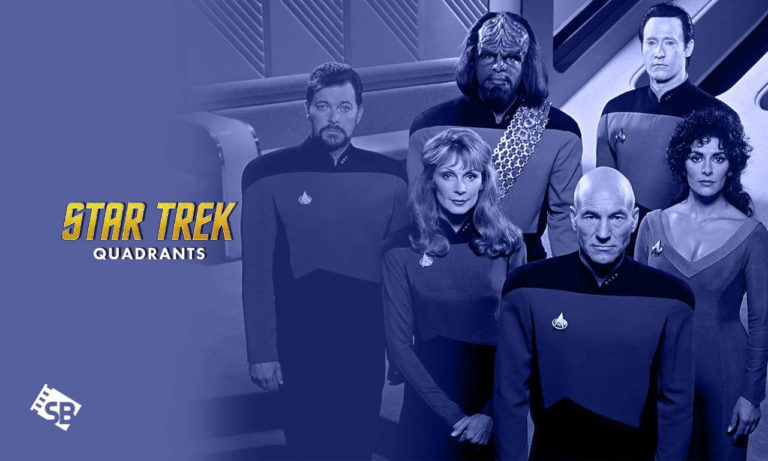
Table of Contents
What Is A Star Trek Quadrant?
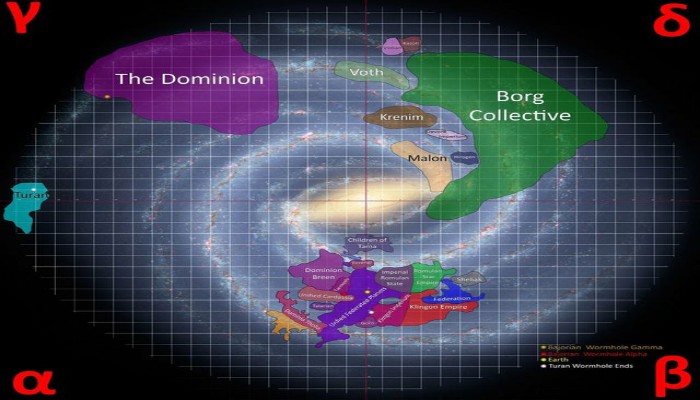
According to the Star Trek Quadrants map in the universe, the “galactic quadrants” are defined by an imaginary meridian that runs across our solar system, which is similar to the concept employed by astronomers.
Instead of going via the Sun as in astronomy, the perpendicular axis in the Star Trek map of quadrants goes through the galactic center.
Accordingly, Star Trek’s quadrant system is less geocentric than normal cartography. In addition, the Greek letters Alpha quadrant star trek, Beta, Gamma, and Delta are used to denote them in the Star Trek galaxy map rather than ordinals, as in the movies.
Star Trek Quadrants Explained
Background Of The Star Trek Quadrants?
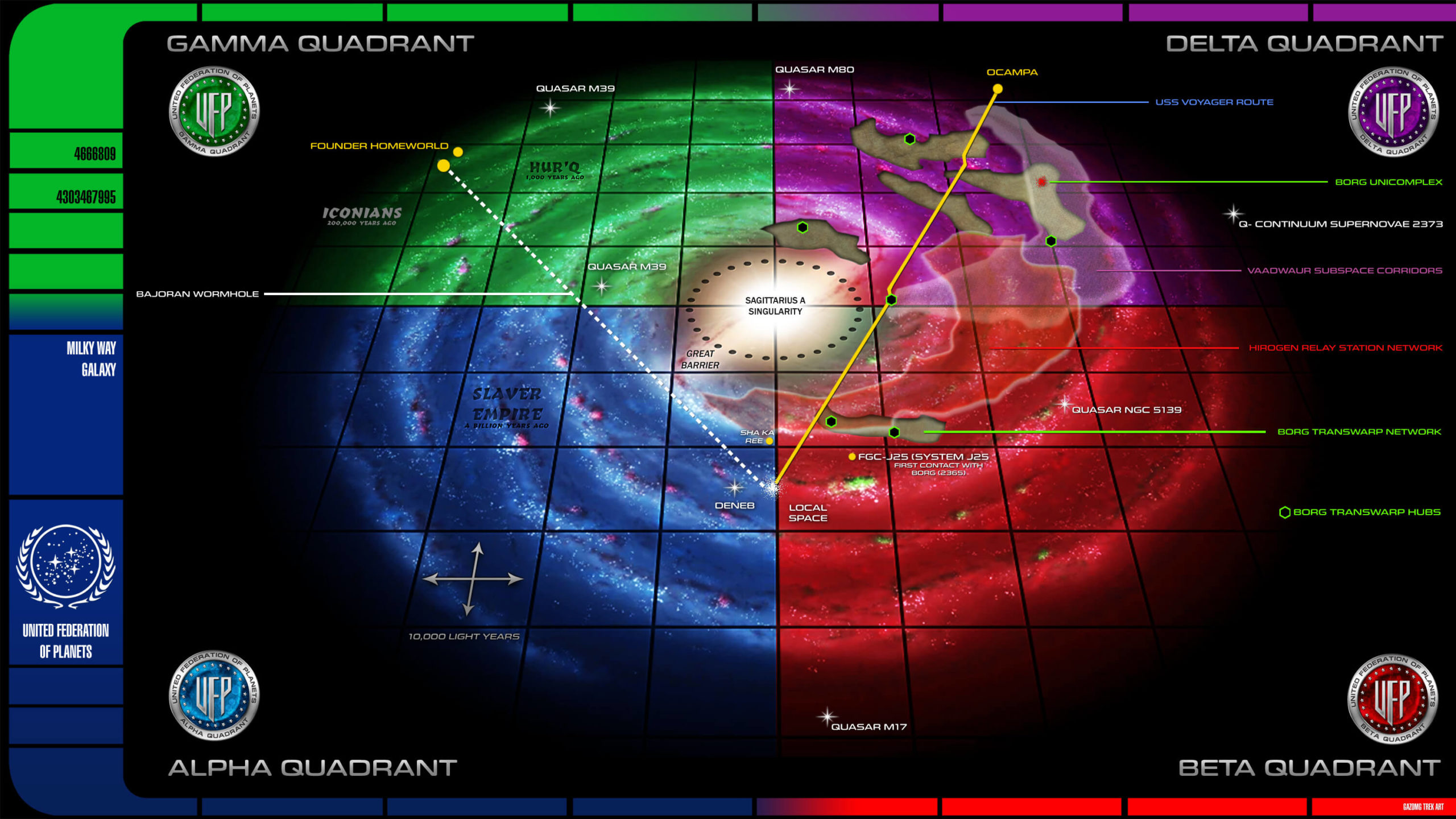
To prepare for the invasion, trans-dimensional entities in the Expanse erected cloaked moons in the area . Their objective was to change the fabric of space in the region, making it hospitable for the Sphere Builders thousands of years ago.
Within a cluster of spheres 700 million kilometers in diameter , a portion of the Expanse has already been transformed into a boiling, organic-looking soup of subatomic particles. One or more spheres provide a command function for the network, which uses artificial intelligence.
As they are hidden, the actual number of spheres is unknown. Thousands of spheres, according to Trianon’s belief. They concluded that there were at least seventy-eight spheres on the star trek Galaxy map and that Degra was one of them.
The Expanse is referred to as the “Chosen Realm” by the Triannons, and their religion is based on the spheres and their mythology. After being stranded in 2037, the spaceship Enterprise from 2154 becomes a generational ship, devoted to fighting the Xindi menace that will emerge in 2150.’s future.’
In 2133, a party of Klingons ventures into the Expanse, only to return anatomically flipped (and still alive). Vulcan ships Seleya and Vaankara also try to investigate the area without success.
The crew of the Seleya, who had been exposed to Trillium-D, were found to be insane and consequently exterminated. Earth’s Starfleet ship Enterprise (NX-01) enters the Expanse in roughly June 2153 in an attempt to find the Xindi.
Later in the year, the Andorian ship Kumari joins the fleet. Reverting twisted space to its original shape and progressively dissolving the thermobaric cloud barrier, the Enterprise destroyed the network of Spheres on F ebruary 13, 2154.
As a result of this, the Expanse fades away into obscurity. Even though a scenario is given to Captain Jonathan Archer of the Enterprise in which the Expanse becomes a significant danger to the future United Federation of Planets , this certainly seems to be removed by the effective destruction of the Spheres. The galaxy is commonly divided into four quadrants, the Alpha Quadrant, the Beta Quadrant, the Gamma Quadrant, and the Delta Quadrant which can be seen if you watch Star Trek movies in order .
Star Trek: The Major Quadrants
According to common belief, the Milky Way Galaxy is divided into four equal-sized cubic quadrants, each defined by a meridian that passes through the galactic center and a second meridian that runs perpendicular to the first and goes through the galactic core.
The four quadrants of the equilateral triangle are known as the Alpha Quadrant, Beta Quadrant, Gamma Quadrant , and Delta Quadrant in mathematics.
The Alpha and Beta Quadrants , respectively, were dominated by alliances with the United Federation of Planets and its bordering powers, such as the Klingon and Romulan Empires.
The Borg Collective and the Dominion , on the other hand, were centered in the Delta and Gamma Quadrants, respectively.
The cosmos appeared to cease to exist for a brief while in the year 2267 when Lazarus and anti-Lazarus began switching places with one another.
Captain Kirk correctly noted in his report that the effects could be felt across the whole quadrant of space. According to Starfleet Command’s Commodore Barstow, afflicted areas covered every quadrant of the Galaxy and far beyond.
Alpha Quadrant
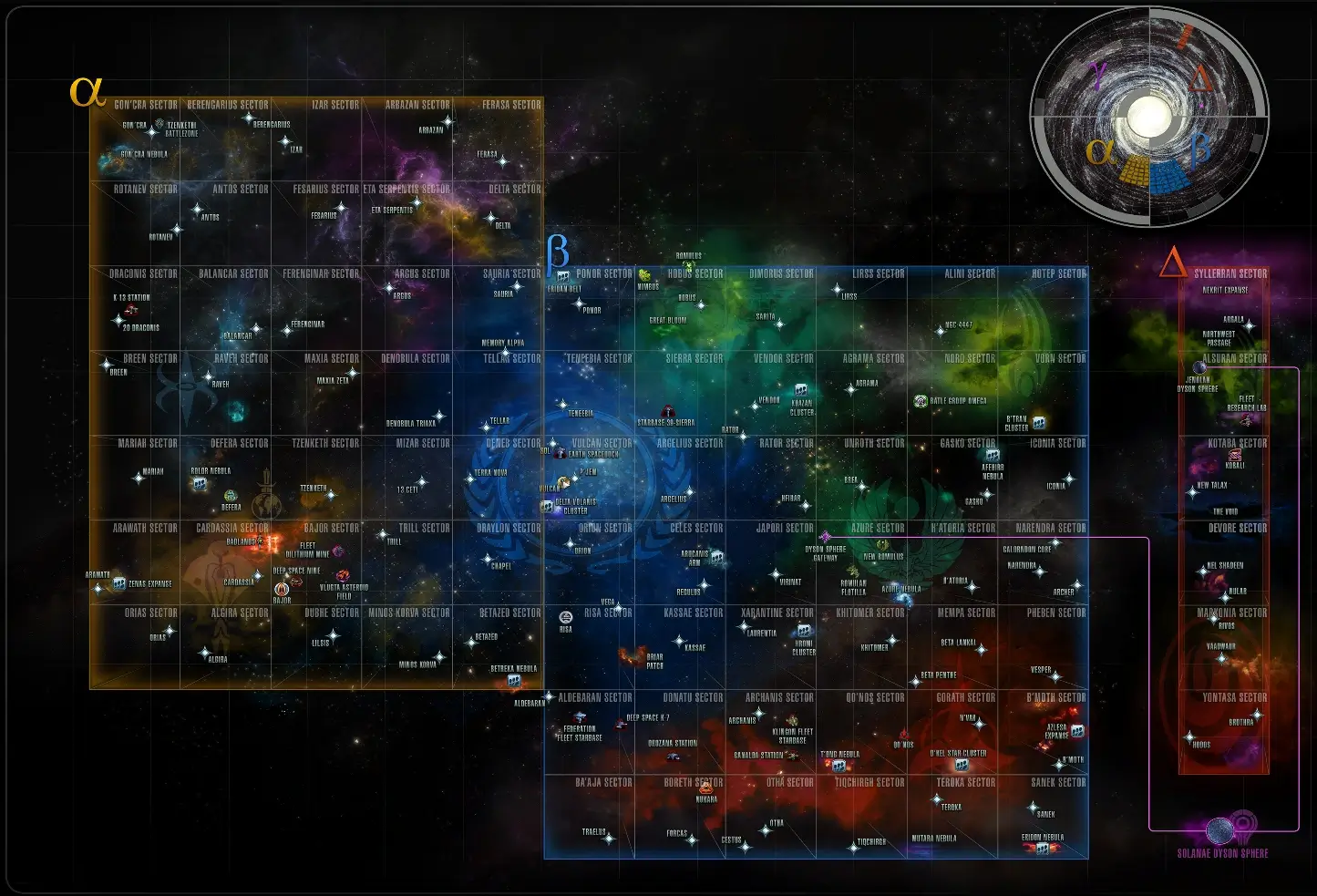
Except for Voyager and Deep Space Nine, the bulk of the franchise’s episodes take place inside the Alpha quadrant of Star Trek of the Galaxy. The planet Earth and a substantial section of the United Federation of Planets may be found here.
Because the planet Earth is situated inside this sector, the great majority of the journey conducted by starships seen in television shows and films takes place within this quadrant.
The Star Trek quadrants, on the other hand, are not bound to a certain area of the Galaxy. This seems to be among the most well-known spot on the face of the planet.
The planets of Trill, Tellar, and Betazed may all be found in this quadrant, along with our solar system, which makes up the whole quadrant.
Some claim that the Alpha sector contains remnants of the Romulan and Klingon civilizations , while others assume the opposite.
Beta Quadrant
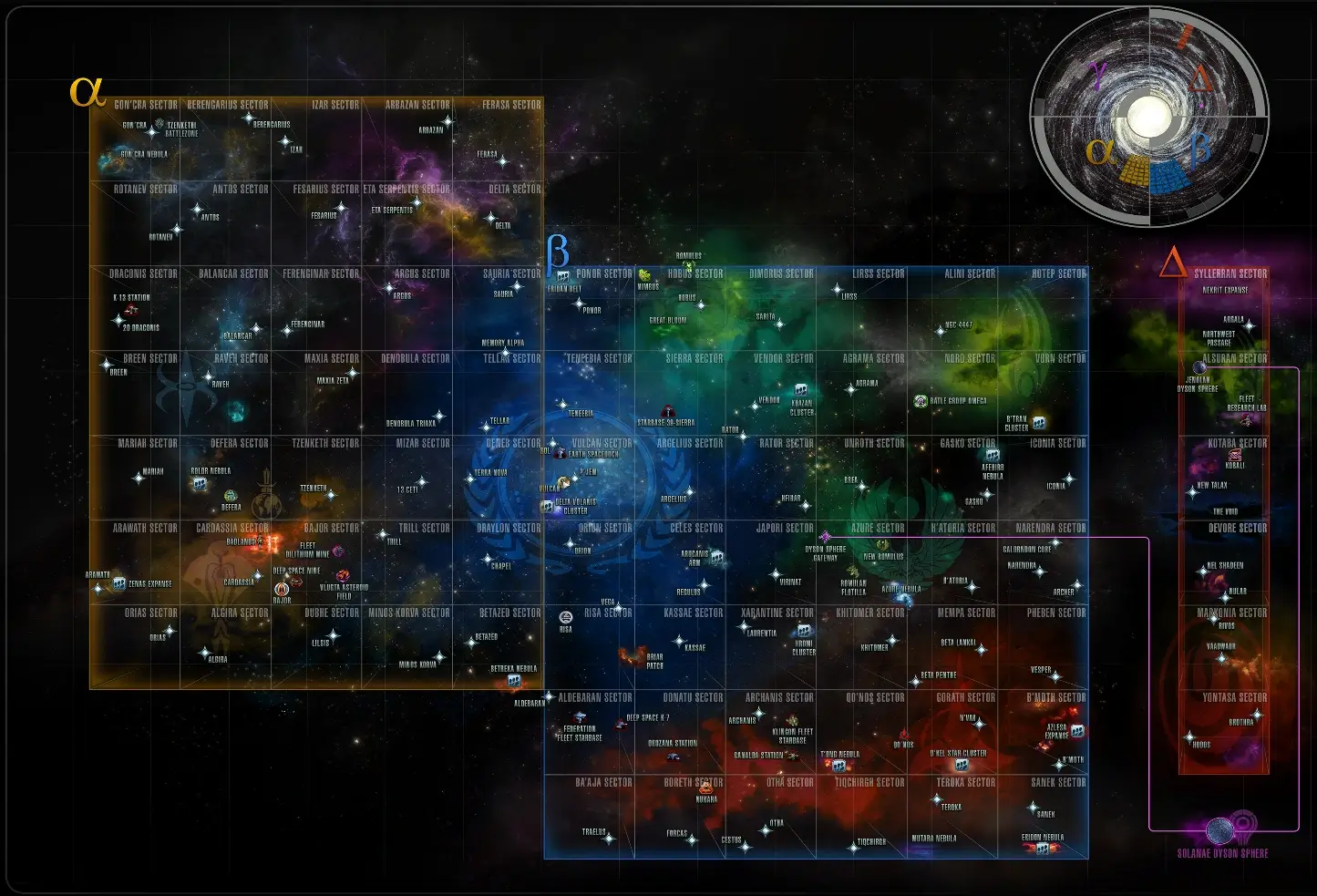
The Beta quadrant contains the rest of the Federation, much as the Alpha quadrant does. This implies that similar to Alpha, many television episodes and movies are set in this sector of the Galaxy.
The vast majority of the Romulan and Klingon empires are concentrated in this area. Beta is also home to Andoria, Risa, Vulcan, and Rigel. Certain publications claim that the Romulan and Klingon empires are entirely contained to a Beta quadrant and do not cross into the Alpha quadrant. These sources are incorrect.
Gamma Quadrant
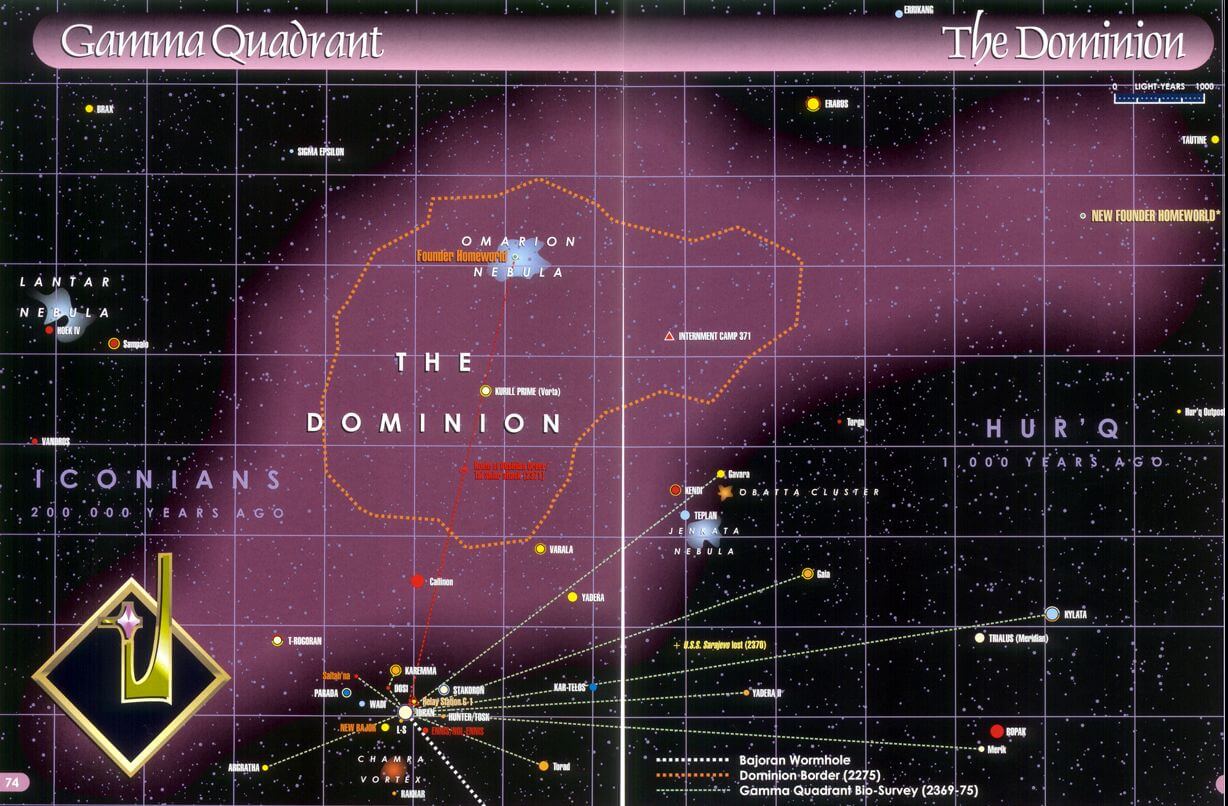
The Star Trek Gamma quadrant was only partially explored until a wormhole was found in the Bajor area in the Alpha quadrant, which allowed for more extensive exploration.
It made it possible for individuals from Alpha to get to Gamma without having to spend years and years traveling.
The Federation was able to communicate with the Dominion via this wormhole, which was dubbed the Bajoran wormhole by the Federation.
This is the foe that we come up against in the television series Deep Space Nine . They are also in charge of the wormhole, which they created.
Delta Quadrant
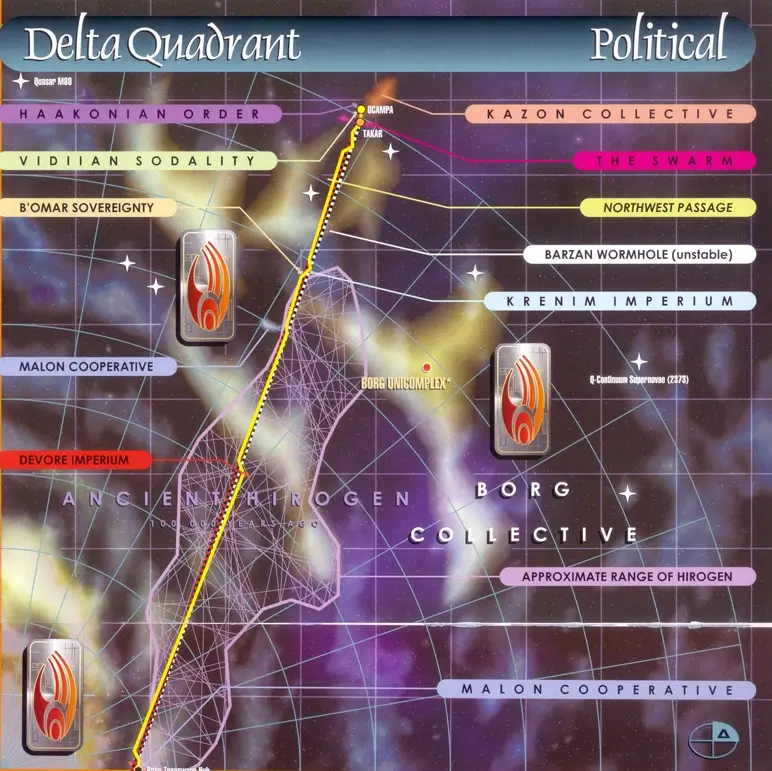
Most of the galaxy’s Delta Quadrant area has gone mostly undiscovered. Reliving their routes back to Earth took the crew of the USS Voyager years to complete.
Return to the beginning location by drawing a straight line from the Alpha and Beta quadrants.
Before the Borg landed in the Delta quadrant, this part of the Milky Way was widely considered to be the home of the Borg. Voyager discovered when returning to Earth that it’s also the homeland of the Kazon, Vidiians, Hirogen, and Species 8472.
Star Trek: The Minor Quadrants
During the 23rd and 24th centuries, smaller parts of space in the Galaxy were called quadrants, which were smaller sections of space inside the Galaxy. Among them were the Quadrant 9, Quadrant 448, Quadrant 904, the Morgana Quadrant, and the Drema Quadrant.
Quadrant 9 is a geographical location in space . This quadrant included a part of the Neutral Zone, which was positioned far enough from Ferengi Alliance territory and protected from attack. As of 2364, there has been no recent evidence of Romulan activity in the area.
Quadrant 448
Quadrant 448 was the site of a renegade comet that had just passed through Gamma Hydra IV in 2267 , according to Stardate 2267 .
Before the present standardization of the quadrant/sector paradigm of celestial cartography, the word “quadrant” refers to a region of the sky.
Quadrant 904
Quadrant 904 was in space in the Milky Way Galaxy, home to several planets. There was a star desert to be found in this area. According to the most recent known data, when the USS Enterprise was first seized by the planet Gothos in this position is 2267, the ship was eight days distant from the planet Beta VI at warp factor three, and Earth was nine hundred light-years away. The Quadrant 904 Central Station served as an embarkation point and a destination for commercial transportation in 2328.
Morgana Quadrant
As per MemoryAlpha , in space, the Morgana Quadrant was a geographical location. Uncrewed Federation ships have already sailed through this area in the early years of the twenty-first century .
During a star-mapping mission that year, the USS Enterprise-D was going to the Morgana Quadrant when it met the lifeform known as Nagilum, a first for the Enterprise-D.
The Enterprise-D was the first human Federation vessel to explore this region when it arrived in 2254 .
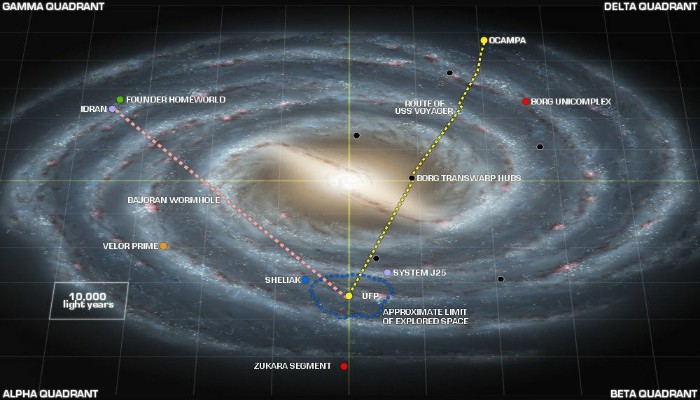
Wrapping Up
In the science fiction television series Star Trek and its spin-offs , a galactic quadrant is a region of the Milky Way Galaxy explored.
The original Star Trek helps to allude to a region that could be interchanged with a sector. Star Trek: The Next Generation and its spin-off programs and films, on the other hand, relate to a system of four galactic quadrants, denoted by the Greek letters Alpha, Beta, Gamma, and Delta in the original series. Each quadrant may be subdivided into sectors, which can be further subdivided.
It’s difficult to estimate the true extent of Star Trek Quadrants because of the large number of variables involved. The human characters in the series have explored a tiny portion of the world.
On the other hand, they have encountered races of aliens that have journeyed around the cosmos, so enlarging it for them. Hopefully, this article has given you a better understanding of exactly how large the Star Trek universe is and how we came to know about it.

Joshua calls himself nerd+geek who is also passionate about rugby. He enjoys comics, animes, and science fiction. He finds his comfort in writing about suspense, thrillers and science fiction shows and movies.
Leave a Reply Cancel reply
Your email address will not be published. Required fields are marked *
Star Trek: Unexplained Anomalies In The Delta Quadrant
Star Trek's Dela Quadrant has a lot of strange things going on beneath the surface...
- Star Trek: Voyager explored various spatial anomalies, such as the Void, Quantum Singularities, Temporal Anomalies, Subspace Sinkholes, and Graviton Ellipses.
- These anomalies often presented challenges and dangers for the Voyager crew, but they also provided opportunities for cooperation and alliances with other species.
- The crew's ingenuity, resilience, and ability to work together were vital in navigating these anomalies and finding ways to escape and overcome them.
Throughout its almost sixty-year history, Star Trek has introduced numerous anomalies in space that led to some of the best episodes of television. This is especially true on the series Star Trek: Voyager where the Voyager crew along with members of the Maquis are taken to the Delta quadrant.
Star Trek Picard: 8 Ways Seven of Nine Has Changed Since Voyager
In a part of space that none of these officers or rebels have ever been, they had to band together to tackle these anomalies together. The series had a way of demonstrating the best of people when different species banded together to achieve a common goal.
This spatial anomaly trapped the Voyager in its crew in the episode aptly titled "The Void." The enclosed section of space was almost completely devoid of matter and energy. The only exceptions were ships that were pulled through the Void's funnels as they randomly opened in space.
The Voyager crew eventually escaped the Void with the help of some new allies and a mysterious species believed to be native to the Void. Voyager managed to escape the anomaly and help free other trapped ships in the process.
5 Quantum Singularities
While this is a broad phenomenon that has been covered multiple times in Star Trek and other science fiction franchises, a quantum singularity is essentially a black hole mixed with some other science fiction creation the writers need for the story. The Voyager crew encountered several quantum singularities during their time in the Delta Quadrant.
10 Best Episodes of Star Trek: Voyager
Quantum singularities created severe time distortions, and mirror images of the ship even caused the crew to get stuck while investigating it. One episode revealed the singularities helped power the Hirogen relay station . In another episode, "Species 8472," one of the most dangerous Star Trek alien races was found to live in a singularity that created interdimensional space portals.
4 Temporal Anomaly
In the episode titled "Shattered," the Voyager was split into thirty-seven different time periods due to an unnamed temporal anomaly. Throughout the episode, Chakotay can move between time periods because he was directly zapped by the anomaly. This also meant that different parts of his body were aging at different rates depending on what time period they were in.
Throughout the episode, he found the parts of the ship were often at some point in the series' past. The rest wound up existing in some type of alternate future depending on what decision would be made in the present. Eventually, Chakotay can get Captain Kathryn Janeway to help him resynchronize the ship.
3 Subspace Sinkholes
Tom Paris , Tuvok, and the Doctor get pulled into an enclosed pocket of subspace thanks to a subspace sinkhole in the episode entitled "Gravity." The shuttle wound up in an area with a star and several planets with their shuttle crashing onto one of those planets. Inside the subspace sinkhole, time advanced at an accelerated rate, meaning the crew experienced a month trapped on the planet for every day on Voyager.
The Voyager crew was able to use a multi-spatial probe as a transporter relay to save their stranded crewmates. This rescue was just in the nick of time as an alien vessel wound up closing the sinkhole not long after, crushing everything inside it.

2 Graviton Ellipses
Humanity first experienced a graviton ellipse in the year 2023 during a mission to Mars when a spacecraft crew was sucked into the ellipse. The Voyager crew found the spacecraft and its pilot, Lt. John Kelly, in the Delta Quadrant centuries later.
6 Underrated Star Trek: Voyager Episodes
The Voyager crew studied Kelly's logs and learned that he was able to survive for a while inside the ellipse and learned of the existence of aliens. He died knowing there was a reason to look to the stars. The Voyager crew gave Lt. Kelly a proper funeral as the anomaly disappeared again.
1 Chaotic Space
Chaotic space is a natural phenomenon in the galaxy in which we live. It's when random sections of space experience fluctuations in the laws of physics. But in Star Trek: Voyager , chaotic space led to the crew flying in a circle rather than in a straight line in their attempt to escape the Delta Quadrant. Meanwhile, gravity distortions damaged the Voyager's hull, giving them no way to escape the anomaly.
During the episode entitled "The Fight," Chakotay starts experiencing hallucinations while in a chaotic space. Eventually, the crew figured out the hallucinations were caused by aliens native to the chaotic space who were trying to help the crew by communicating with Chakotay. The crew eventually escaped thanks to the help from the aliens and a dormant gene in Chakotay that made him predisposed to hallucinations.
MORE: Star Trek: Unluckiest Characters
1 hr 11 min
The One with Lisa Klink Mission Log: A Roddenberry Star Trek Podcast
As we say goodbye to season 4 of Star Trek: Voyager, we say hello to writer Lisa Klink! Lisa spent three seasons in the Delta Quadrant, and in this interview she reminisces about shaping some of her favorite episodes, areas left unexplored, and stories that didn't hold up quite as well as others. Sponsored by - take 50% off your first box with code "missionlog50" Sponsored by - three-for-two exclusive sale on Star Trek: Discovery!
- Episode Website
- More Episodes
- ©2012 Roddenberry Entertainment
- More to Explore
- Series & Movies
Published Jun 12, 2023
Children of the Delta Quadrant, Ranked
Ranking the alien kids encountered by Voyager helps us assess the Delta Quadrant’s future.
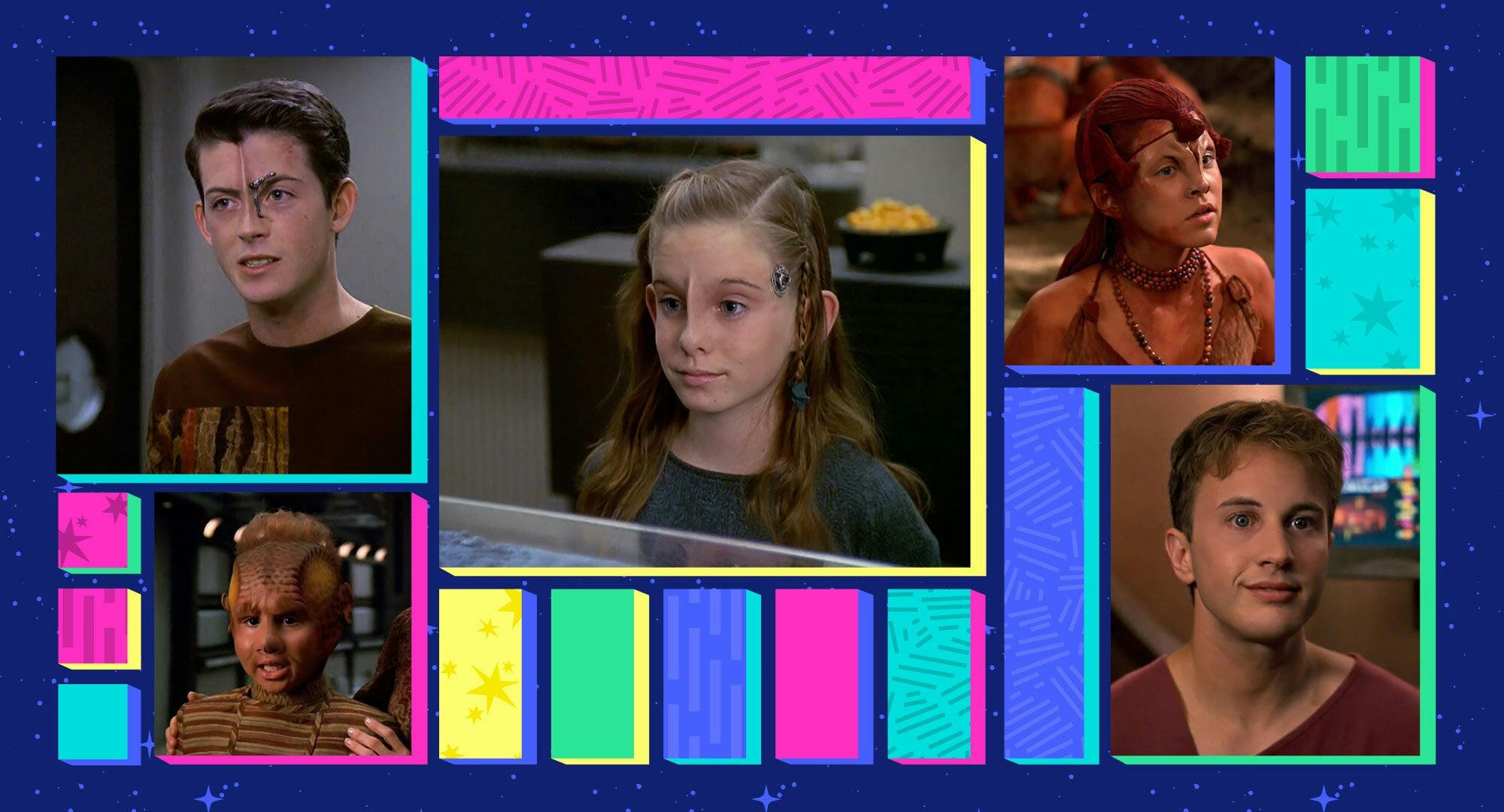
StarTrek.com
My eyes may have welled up when the U.S.S. Voyager finally burst through the Borg sphere to get back to Earth on Star Trek: Voyager — but after the initial joy wore off, I felt a certain unease. The crew was now safe at home, yet what of the alien friends and foes left behind in the Delta Quadrant ?
Fast forward 19 years and, while Star Trek: Picard filled in a few holes, we are still no closer to knowing the fates for all involved. After much deliberation, I have decided the only solution — for us and for the Federation — is a ranking of the Delta Quadrant’s alien children. Let me explain.
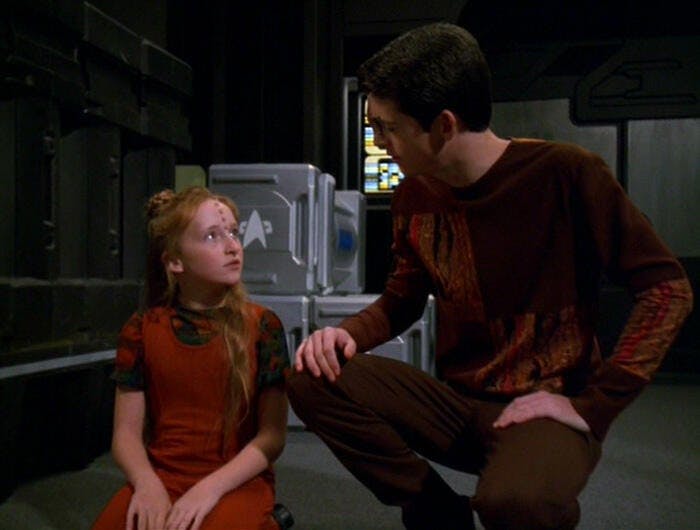
Children provide insight as to the fundamental qualities and values of alien cultures. Furthermore, nearly two decades after their encounters with Voyager , many of them are now in the prime of their lives, ready to take the reins from an earlier generation. In short, children are the future and one of the best indicators of the quadrant’s likely development. Plus, ranking them can help Starfleet determine which species to engage and stay away from should they ever get back to that region of space.
Before diving in, let’s talk methodology. The criteria for initial placement on the list are rather loose, but broadly speaking the ranking includes any alien children — from toddler to teenager — that interacted directly with Voyager ’s crew. Their placement, from worst to best, is determined through a subjective comparison to the objectively perfect Voyager child, Naomi Wildman . She represents all that is good — curiosity, kindness, resourcefulness, wisdom, loyalty, compassion, for a start —so it is only fair that she serves as the benchmark. In fact, all the children will be given a score of 1 to 10 “Naomis.”
With that in mind…
15. Unnamed Children (Vaadwaur)

Shortly after Voyager reactivates the Vaadwaur stasis pods in “ Dragon’s Teeth ,” we learn that their children are taught to “fall asleep each night imagining a different way to die.” Morbid!
Later in the episode, Naomi informs us that they were making cruel jokes about Neelix and Talaxians. She knows that xenophobia is wrong, and so do we. The Vaadwaur may be “resourceful” as Captain Janeway says, but judging from their children, their future is bleak. Frankly, I am glad we never got to see what the Vaadwaur kiddos looked like. 0 Naomis . Next.
14. Suspiria ( Nacene )
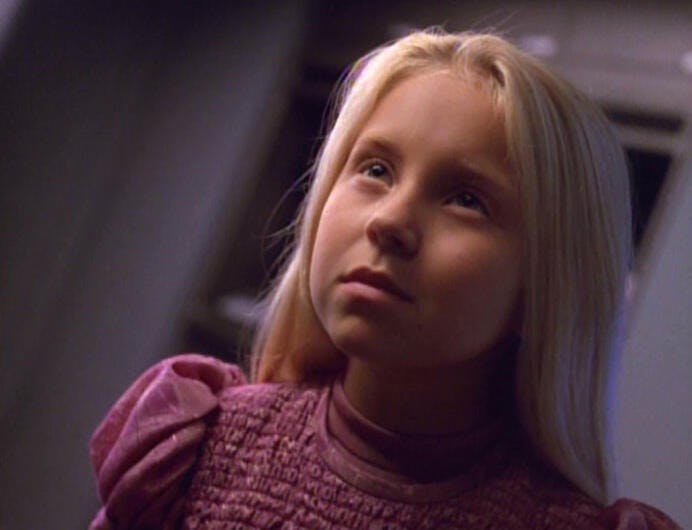
Though Suspiria is thousands of years old, she appears on Voyager as a terrifying young girl in “ Cold Fire .” Before Kes and a bioweapon stop her rampage, she nearly destroys the ship and hurts several of the crew with her psychokinetic abilities. Suspiria is truly the stuff of nightmares, but she did take care of a group of Ocampa for generations. And to be fair, she thought Voyager ruthlessly killed her mate — the Caretaker. Redemption is possible. ½ Naomi
13. Kar ( Kazon )

A part of me feels bad ranking Kar, the Kazon boy of “ Initiations ,” third to last. After all, he’s been raised to be a good Kazon, and they are not the friendly sort. Kar gets bonus points for not murdering Chakotay in his sleep when the two are stuck in a moon cave together. On the other hand, he did try to kill the commander earlier in the episode and never thanked him for saving his life. (Rude!) At the end of the episode, he kills First Maje Razik of the Kazon-Ogla, falling back into classic Machiavellian tactics. It seems the Kazon will never change. 1 Naomi
12. Karya (Vori)
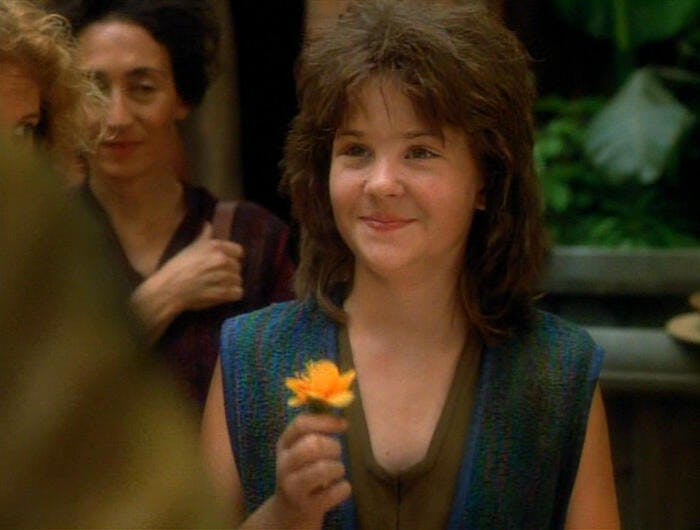
When Chakotay crash lands in the middle of a brutal conflict between the gallant Vori and the beastly Kradin, Karya, a young Vori girl, helps nurse him back to health. Later, she valiantly defends her grandfather when he is presumably being taken to be killed. Or does she? By the end of “ Nemesis ,” we find out that Karya is actually a “photometric projection” designed to brainwash the commander into fighting an alien war. There is a lot to be said for Karya’s caring qualities, but we will never know if real Vori children are anything like her. As a result, she gets only 1½ Naomis due to her role in the mind-control program.
11. Unnamed Infant (Reptohumanoid Species)
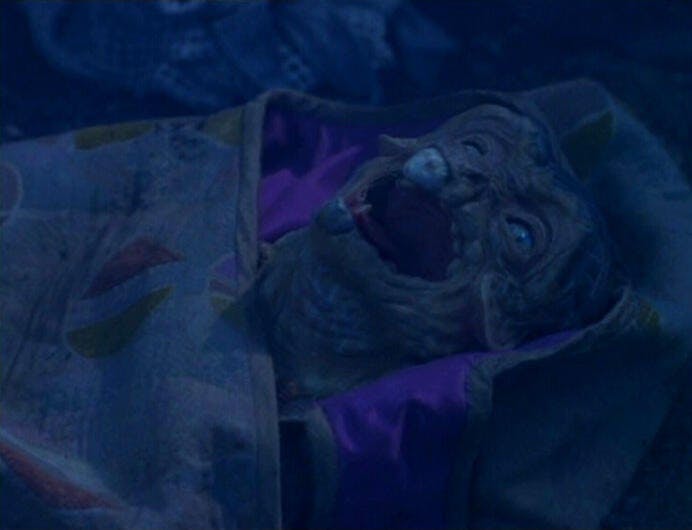
It is nearly impossible to judge a freshly hatched baby, but we ought to try. The infant in question was encountered by Tom and Neelix on a food-gathering away mission in “ Parturition .” Not much can be said about the beaked babe, but it did allow itself to be fed and made the equivalent of reptilian cooing sounds. That alone is worth 2 Naomis .
10. Q Junior ( Q )
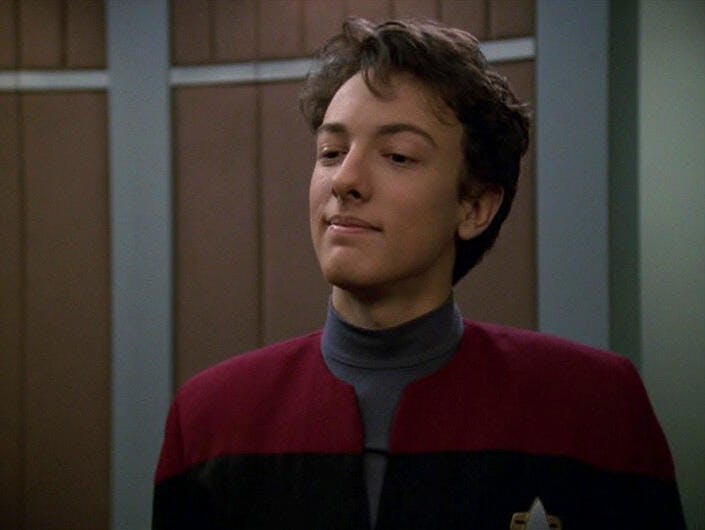
Q Junior makes two appearances on Voyager in “ The Q and the Grey ” and “ Q2 .” As a child, he passed the time by “starting wars among innocent species.” His mischief on Voyager — fusing shut Neelix’s mouth and redecorating engineering as a dance club, among other shenanigans — was of a smaller scale, but still disruptive. After being temporarily relieved of his powers and left behind with Captain Janeway and the crew, Q Junior eventually learns the value of hard work and accountability. I have always hoped that, like Seven, he would make up for the chaos he wrought earlier in his life. 3 Naomis
9. Azan and Rebi (Wysanti)
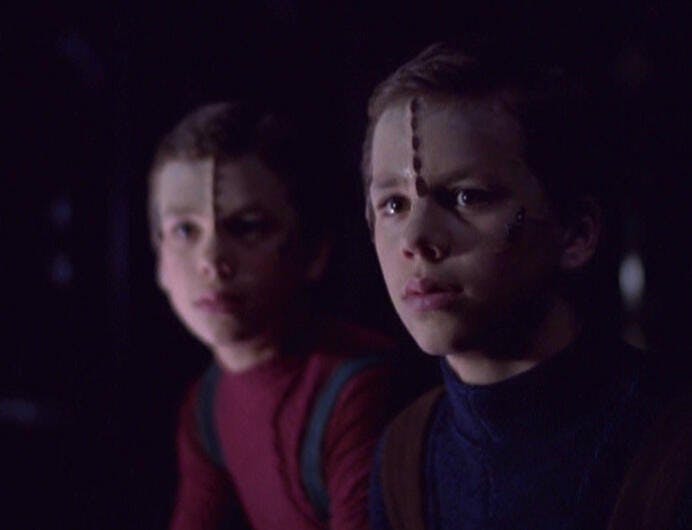
Twins Azan and Rebi were featured in several episodes after being rescued from the partially disabled Borg Cube in “ Collective .” The twins showed an aptitude for science and precision, but also for telepathicallty cheating at kadis-kot, and for messing with one of Tuvok’s holodeck programs under the direction of Harry Kim. They are fundamentally good boys, but not that impressive. 4 Naomis
8. Mezoti (Norcadian)
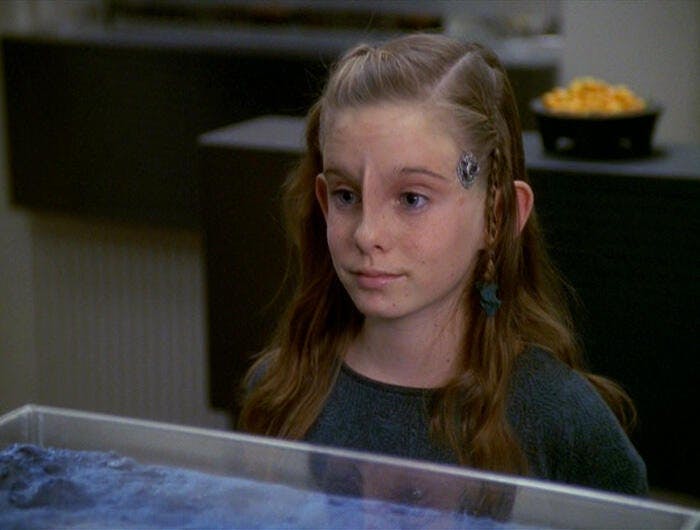
Mezoti was also rescued from the broken Borg Cube, and retained the Collective’s scientific prowess. Like the twins, she misbehaved at times. However, she developed a greater sense of individuality, affection for her friends, and appreciation of beauty. For that we award her 4½ Naomis .
7. Tressa , Corin , and Elani (Drayan)
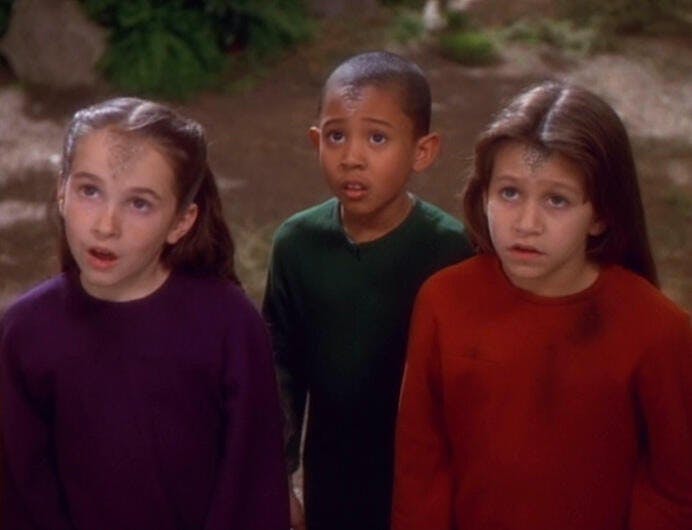
Ok, so technically the children who camp out with Tuvok on a Drayan moon in “ Innocence ” are elderly (the Drayans age backward). They are referred to as “children,” though, making an assessment fair game. Nothing is wrong with Tressa and the others per se, but by the time we meet them, they are disobedient, fearful, and forgetful. Nevertheless, judging by the respect afforded them by First Prelate Alcia, they have each probably contributed much to Drayan society. Tressa, for example, has a grandson who reminds her of Tuvok. Major contribution indeed. 5 Naomis
6. Yun (Unnamed Species)
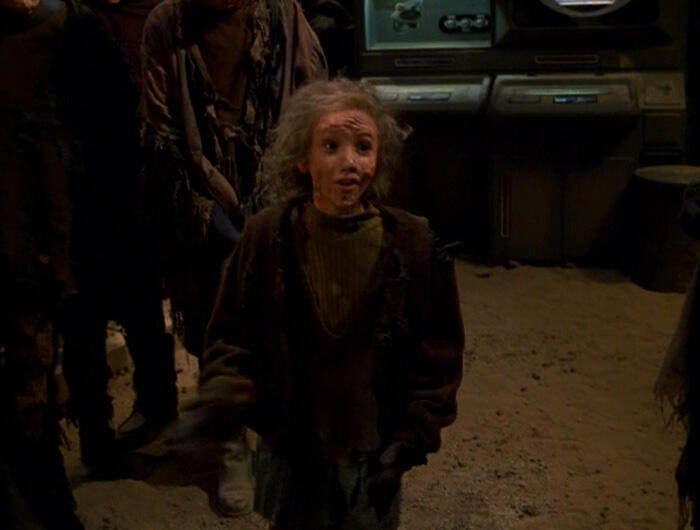
Yun, a young girl suffering from prolonged radiation exposure, in “ Friendship One ,” does not play a significant role in the episode but represents key Naomi values. She shows a high level of curiosity when approaching Tom and Neelix, who are her species’ captives. Yun is later one of the first of her kind to venture outside when the radiation clouds part, and joyfully implores the others to follow. High marks for optimism. 5½ Naomis
5. Latika (Unnamed Species)
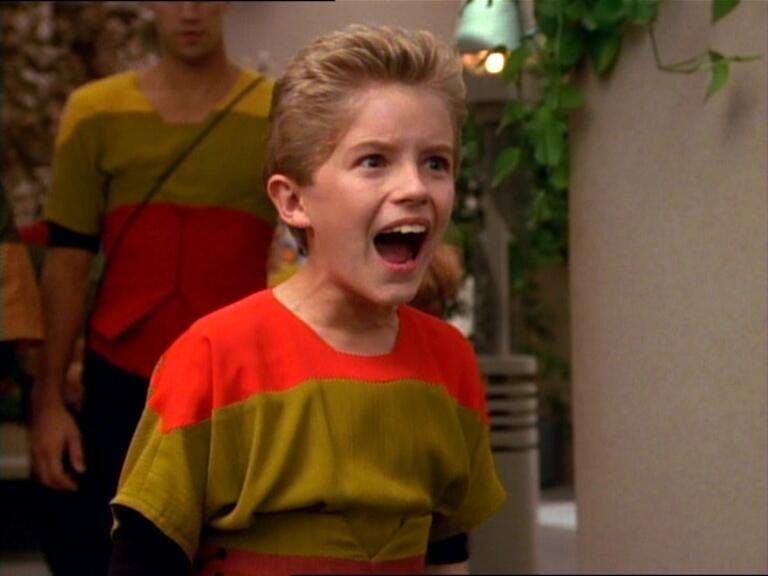
Let’s be honest — Latika, the intrepid little investigator, of “ Time and Again ,” rubbed us the wrong way when we first met him. His top priority was unmasking Captain Janeway and Tom as demons. Upon further reflection, though, I believe that his brand of “speaking truth to power” was sorely needed in his world and is an admirable quality in an aspiring journalist. 7 Naomis
4. Brax ( Talaxian )
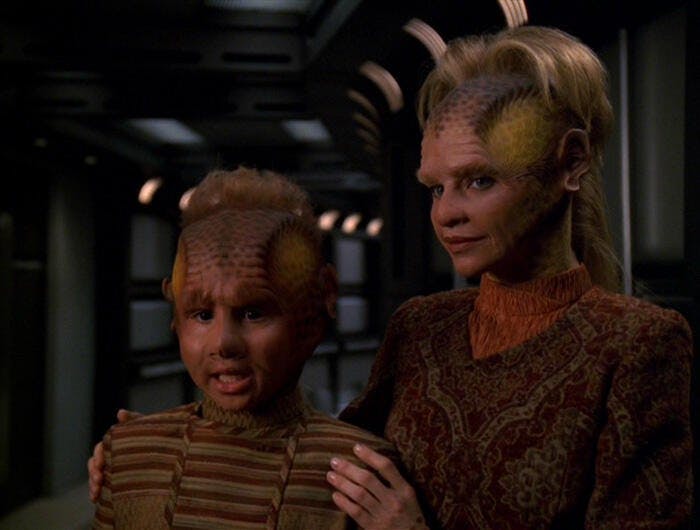
Neelix left Voyager in “ Homestead ,” partially because of his growing affection for Brax, the young Talaxian boy who could be seen as Naomi’s natural successor. Brax is quick to show commendable traits when he valiantly talks to then-prisoner Neelix for the first time. Brax later shows daring when he sneaks onto the Delta Flyer, courage when protecting his mother from the Nocona, and fearlessness when Naomi invites him to try a new holodeck program. A few negative marks for being one-dimensional and constantly nagging Neelix about keeping his promises, but he still gets 7½ Naomis
3. Unnamed Girl (Ventu)
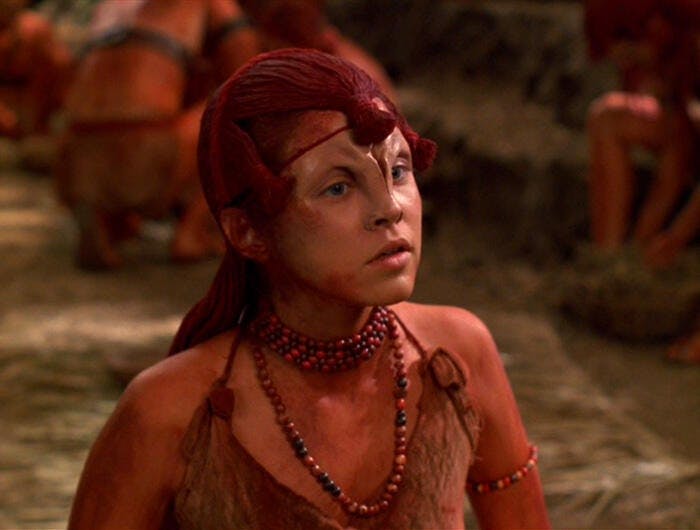
The Ventu girl who takes a liking to Seven in “ Natural Law ” comes from one of the least developed societies encountered by Voyager , but her praiseworthy qualities shine through. While guiding Seven through the woods, she shows herself to be inquisitive, resourceful, and in awe of nature. She is also patient with Seven’s sometimes prickly attitude and saves her from starvation and the cold with gifts of food and a blanket. In another life, she and Naomi would be good friends. 8½ Naomis
2. Tebbis (Dinaali)
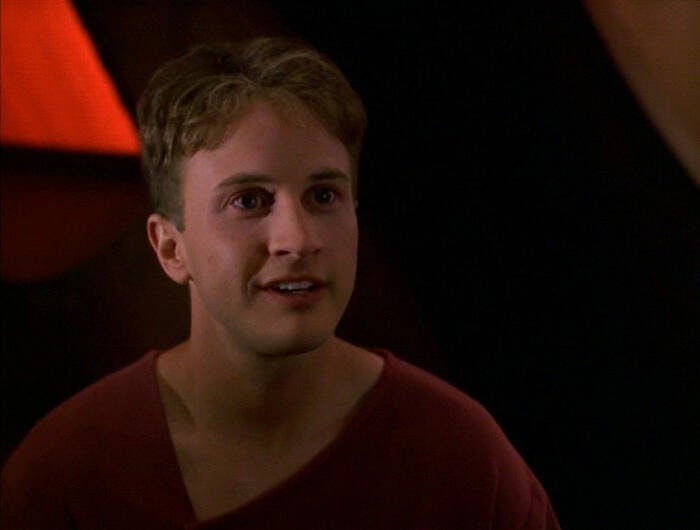
Tebbis’s story in “ Critical Care ” is one of the most tragic of the series. A young miner, Tebbis ends up in a hospital from hell with a chromoviral infection. His talent for and love of medicine was matched only by his selfless care for fellow patients. Tebbis inspired The Doctor to creatively obtain several unauthorized cytoglobin injections with which to treat him. Unfortunately, the Doc’s subterfuge was discovered, and the young man died after exceeding his pharmaceutical allocation. Rest in peace, Tebbis. 9 Naomis
1. Icheb (Brunali)
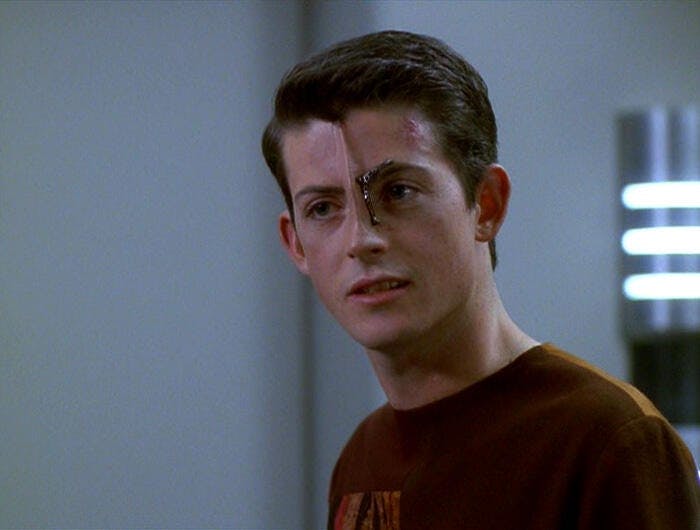
Like the other children rescued from the Borg Cube in “ Collective ,” Icheb was not perfect. He showed himself to be timid, disobedient, and awkward at times. Yet, his good qualities far outweigh his flaws. Of all the children listed, he was the most naturally precocious and the quickest learner, becoming an expert in fields as disparate as astrophysics and genetics. He used his brilliance to assist Voyager in several capacities and received high praise from several of the senior staff. Icheb also cared deeply for the younger children, taught Q Junior wholesome values, kept Chakotay’s secret about a stash of cider, nearly sacrificed his own life to save Seven, and even empathized with his parents — who had tried to kill him. Through all that, he remained the humblest member of the crew. It is no wonder that Icheb and Naomi were fast friends, even in an alternative timeline where we saw them as adults (“ Shattered ”). 10 Naomis
This article was originally published on May 19, 2020.
Get Updates By Email
Stay tuned to StarTrek.com for more details! And be sure to follow @StarTrek on Facebook , Twitter , and Instagram .
Daniil Davydoff (he/him) is Director, Research Management and Operations at Eurasia Group and a Carnegie New Leader with the Carnegie Council for Ethics in International Affairs. He has written for Security Magazine, Risk Management Magazine, Disaster Recovery Journal, Foreign Policy, and The National Interest, among other publications. Intrepid readers should connect with him on LinkedIn, the Delta Quadrant of social media networks.
- Societies and Cultures


- View history
The Briori were a species from the Delta Quadrant .
In 1937 , the Briori abducted over three hundred Humans from Earth , including famous female pilot Amelia Earhart , and transported them to a planet in the Delta Quadrant to be used as slave labor. The Human slaves revolted, however, and overthrew their Briori masters, taking their weapons and technology, and eventually establishing a thriving settlement.
Fifteen generations later, in the year 2371 , the settlement was discovered by the crew of the USS Voyager , along with Earhart and seven other Humans who were the only abductees who had been left in suspended animation . ( VOY : " The 37's ")
External link [ ]
- Briori at Memory Beta , the wiki for licensed Star Trek works
- 3 Ancient humanoid

Giant Freakin Robot
Star Trek's Best Writer Predicted Voyager's Biggest Weakness
Posted: April 11, 2024 | Last updated: April 11, 2024

Star Trek’s Best Writer Predicted Voyager’s Biggest Weakness
Star Trek: Voyager has a legion of fans, but the show has also had some very fierce criticisms over the past decades. Perhaps the most common criticism is that the show overused the Borg, giving us so many run-ins with these cybernetic villains that they no longer seemed like a nearly unstoppable threat. Ironically enough, one of the best Star Trek writers, future Battlestar Galactica showrunner Ronald D. Moore, predicted this problem while writing on The Next Generation episode “I, Borg,” years before Voyager was created.
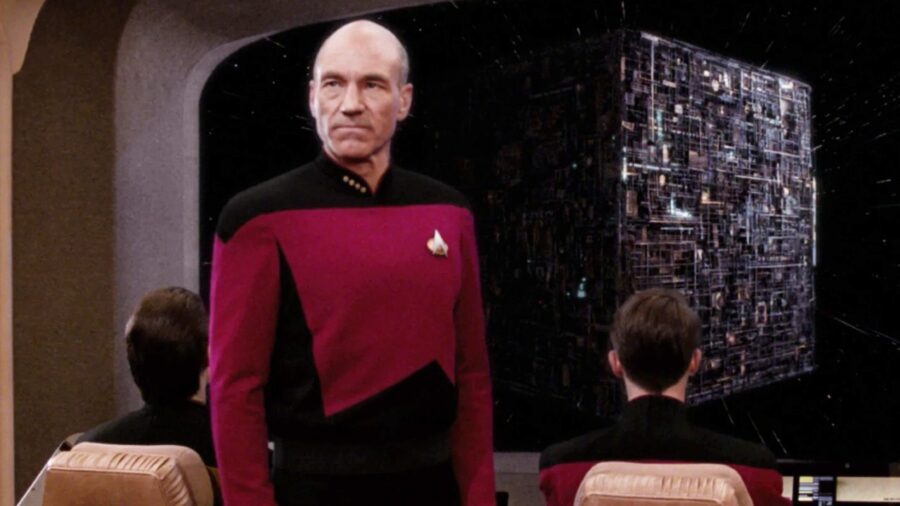
The Borg Were a Major Threat
The Star Trek: The Next Generation episode “I, Borg” was the first episode to bring these bad guys back since the explosive two-part episode “The Best of Both Worlds.” In those episodes, we saw how the Borg easily obliterated 39 Starfleet vessels at the Battle of Wolf 359, and the only reason the Enterprise was able to stop the Borg Cube before it could attack Earth was by hacking into their Collective through the assimilated Captain Picard. The show’s writers knew they wanted to bring these fan-favorite foes back, but they had to find a way to explain how the Enterprise could survive another encounter.
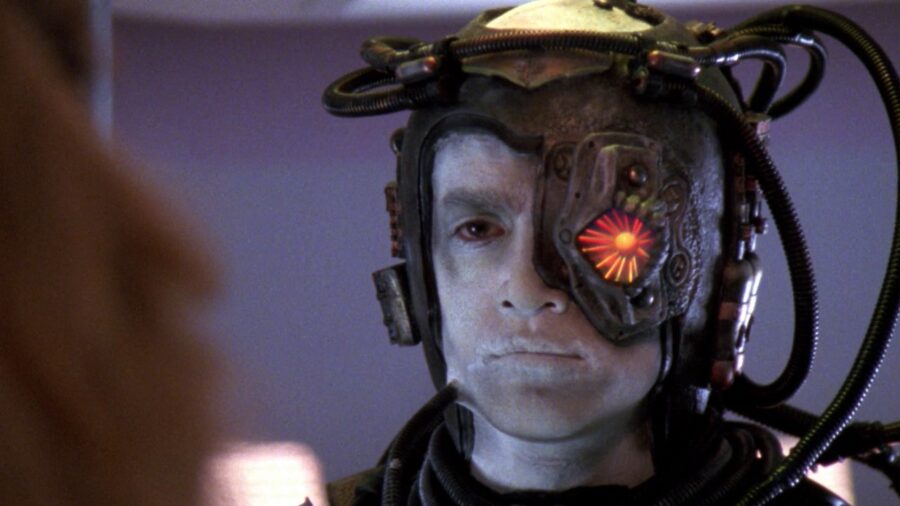
Hugh Develeoped A Personality Once He Wasn’t Terminally Online
Eventually, the Star Trek writers came up with a clever answer: instead of “I, Borg,” having the ship and crew fighting an entire Borg vessel, they must figure out what to do once they rescue the lone survivor of a crashed Borg ship. That survivor is Hugh, a Borg who develops his own personality once he is separated from the Collective. Captain Picard must then face the moral dilemma of whether to send Hugh back to the Borg with a virus that could wipe out the entire Collective or allow him to seek asylum, something which might put the Enterprise in perpetual danger.
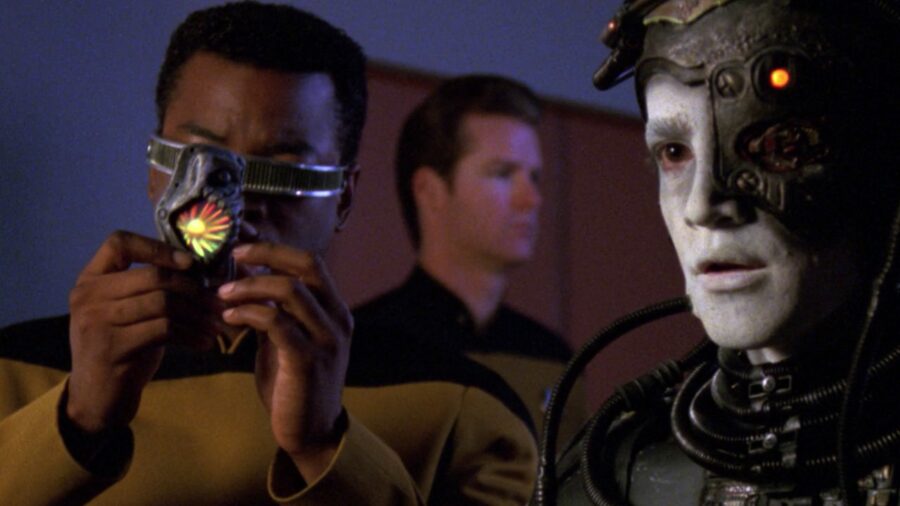
Stop Stopping Unstoppable Villains
That Star Trek episode ends on a bitter note, with Hugh (who appears in a later TNG two-parter as well as the first season of Picard) choosing to return to the Collective to protect the Enterprise and his new bestie, Geordi LaForge. Though he didn’t write this ep, veteran Star Trek writer Ronald D. Moore praised the story as “a real good way to bring the Borg back” instead of having another fight because “we keep saying they’re unstoppable and if we keep stopping them it undercuts how unstoppable they truly are.”
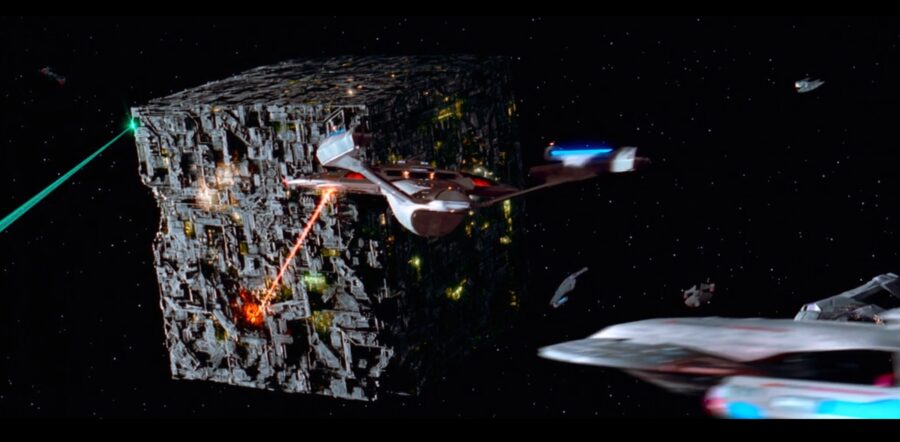
Somehow The Borg Returned
For the most part, Star Trek: The Next Generation stuck closely to Moore’s thoughts about the Borg. The Enterprise crew never fought against the proper Collective again in the series, with their last TNG appearance having our protagonists fighting a splinter group of Borg who were weakened by Hugh’s individuality before being discovered and weaponized by Data’s evil brother Lore. The Enterprise was able to defeat a Borg Cube in First Contact, but only with the help of an entire fleet and Picard’s special knowledge (courtesy of his prior assimilation) about the vessel’s secret weak point.
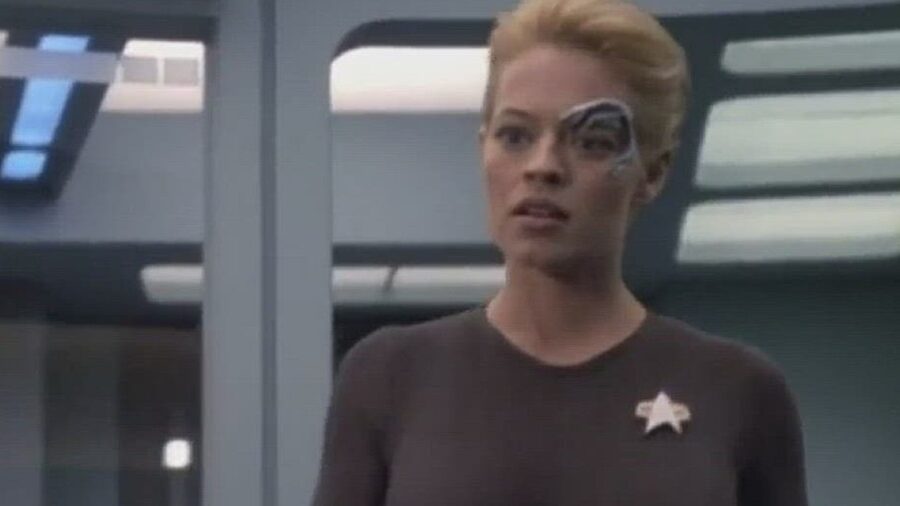
Fan Favorite Borg
Fast-forward to the third season finale of Star Trek: Voyager, and the Borg (who originated in the Delta Quadrant) made a splashy appearance that ultimately gave us the fan-favorite character Seven of Nine. That two-parter was great, but the show kept returning to these villains. By the time Voyager was over, the Borg would appear (in one form or another) in a whopping 23 episodes.
Even for the biggest fans of Star Trek: Voyager, this led to constant questions of why the Borg didn’t simply destroy Voyager as easily as they destroyed all of the ships at Wolf 359. In fact, it was almost certainly those fan questions that prompted a specific line of dialogue in the series finale “Endgame” where the Borg Queen tells Seven of Nine “You’ve always been my favorite” and that because Seven cares for the Voyager crew, the Collective has “left them alone.”
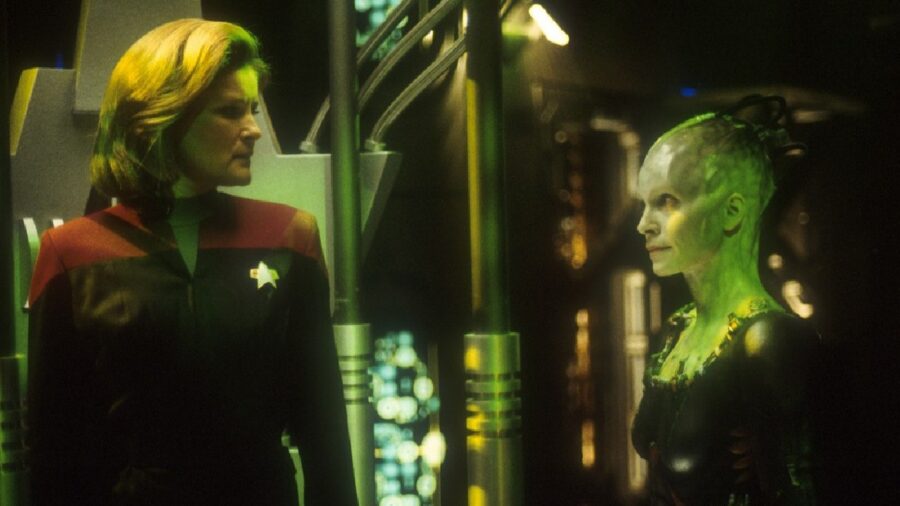
Voyager Made Sense At The Last Possible Moment
In other words, Star Trek: Voyager did address (albeit at the very end) why the Borg didn’t just assimilate Janeway and her crew, but that doesn’t change the fact that the prophecy of Moore came true: constantly showing our heroes defeating these “unstoppable” foes made them seem like far less of a threat. Unfortunately, the franchise didn’t learn from this lesson, and the Borg honestly seemed less threatening than ever before when they returned (with what I can only hope was a last gasp) in the third season of Picard.
For this viewer, the de-fanged Borg proved one thing: that yawning, like resistance, was completely futile.
More for You
Ryan Gosling and Kate McKinnon's ‘Close Encounter' Sketch Sends ‘SNL' Cold Open Into Hysterics
RFK Jr. says he has ruled out Libertarian run for president
‘Golden Bachelor’ breakup suggests the many challenges of dating at older ages, says expert
Famous figures who had Titanic tickets but didn't make it on board
7 CDs You Probably Owned, Threw Out and Now Are Worth Bank
15 Boxed Cake Flavors That Are Probably Gone Forever
Nike responds to backlash over Team USA track kits, notes athletes can wear shorts
Worried about microplastics in your water? You can get rid of them with common kitchen items
Iranian missile intercepted over Jerusalem
This Small South Carolina Island Has 10 Miles of Pristine Beaches and One of the Best Resorts in the State
Anheuser-Busch has ‘learned their lesson’: Former exec Anson Frericks
Damning Warning Issued Over Florida Insurance Market
26 barges break loose on Ohio River in Pittsburgh; some go over dam
Putting money in bank accounts is 'the worst thing you can do' for taxes, says former Intuit CEO
78 Riddles for Adults That Will Test Your Smarts
Cover Up Unsightly Floor Scratches In A Pinch With This All-Natural Item
Explosions, Sirens Heard in Israel, West Bank and Jordan After Iranian Attacks
More than half of foreign-born people in U.S. live in just 4 states and half are naturalized citizens
Masters 2024: Tiger Woods shares touching final handshake with Verne Lundquist on 16th hole
Supreme Court to debate 'sleeper' case that could affect Trump federal prosecution
Screen Rant
Star trek: voyager predicted ai-generated art 23 years ago.
Star Trek: Voyager season 7 seems to argue in favor of AI-generated artwork, but what does Star Trek really have to say about generative AI?
- Star Trek: Voyager's Doctor raises questions about AI rights in art, highlighting the ethical issues of AI-generated artwork.
- The Doctor's holonovel dilemma parallels today's AI art landscape, where AI-generated work lacks copyright protection.
- The future of AI in Star Trek lies in the holodeck, acting as a more advanced form of generative AI compared to the Doctor.
Today's debates around AI-generated art were predicted by Star Trek: Voyager 23 years ago. In Voyager season 7, episode 20, "Author, Author", Voyager's holographic Doctor (Robert Picardo) writes a holonovel called "Photons Be Free", which draws heavy inspiration from the Doctor's own experiences interacting with the crew of the USS Voyager . The novel is a hit in the Alpha Quadrant, but there's a wrinkle when the unfavorable depiction of the Voyager crew prompts the Doctor to reconsider his artistic approach. The Doctor resolves to make revisions to the program's characters but discovers that he's legally unable to do so.
As an artificial life form, the Doctor can be compared to characters like Star Trek: The Next Generation 's Lt. Commander Data (Brent Spiner). Data's personhood was legally determined in TNG season 2, episode 19, "The Measure of a Man", which provided the blueprint for future Star Trek courtroom dramas debating the rights of life forms that don't fit the default human model. Starfleet determines that Data is a person, and entitled to all the rights thereof, so the precedent set in "The Measure of a Man" implies that Star Trek is in favor of civil rights for artificial intelligence. But what does Star Trek have to say about AI art?
Star Trek: Voyager’s 15 Best Doctor Episodes
How star trek: voyager's doctor compares to modern generative ai, the emergency medical hologram creates art more like a human..
Star Trek: Voyager 's question about whether AI like the Doctor has rights as an artist feels unusually prescient in today's AI-saturated art landscape. With characters clearly based on Voyager's crew and events in the novel echoing familiar Star Trek: Voyager stories, the Doctor's holonovel is derivative in a way that resembles today's AI-generated artwork, particularly because modern AI must be trained on a body of work created by humans who haven't consented to the use of their creations -- or, like on Voyager , their likenesses. Just like the publisher arguing the Doctor has no legal claim to "Photons Be Free", artwork created by AI today can't be copyrighted.
There's a vast difference between the AI that generates artwork in the 2020s and Star Trek: Voyager 's Doctor. Today's AI models rely heavily on pattern recognition to algorithmically generate work based on the examples that they've been trained on. Generative AI uses those examples to predict what words or pixels are most likely to appear in proximity to one another, given the data it has access to. Sentient holograms on Star Trek , however, are narrative stand-ins for marginalized groups. The Doctor gains some civil rights because Star Trek: Voyager 's story is actually saying that human artists should have control of their work , not that AI models are people.
Data's rights as a creator were called into question in TNG season 3, episode 16, "The Offspring", after Data created his daughter, Lal (Hallie Todd), but the inconclusive nature of Lal's case means there's no precedent for the Doctor's petition for holographic rights.
The Real Future Of Generative AI On Star Trek Is The Holodeck
The holodeck is like an advanced form of today's ai learning models..
The future of generative AI on Star Trek isn't in its characters, but the holodeck. Like modern AI models, the holodeck generates work based on user prompts, with personal programs containing parameters for specific story elements like characters, environment, and narratives. Star Trek 's holodecks , like those on the USS Enterprise-D in Star Trek: The Next Generation and the USS Voyager, are essentially trained on information from ships' databases to predict what happens, and what that looks like in fully-realized, immersive 3D. Privately-owned holosuites like on Star Trek: Deep Space Nine may rely on smaller data sets, but can still only generate characters based on pre-existing parameters.
In Star Trek: Deep Space Nine , season 3, episode 8, "Meridian", Quark (Armin Shimerman) must get a scan of Major Kira Nerys (Nana Visitor) to satisfy a customer's desire to put Kira in a holosuite program.
The holodeck is a far better example of AI-generated art in action than the Doctor in Star Trek: Voyager . In Star Trek: Lower Decks season 3, episode 8, "Crisis Point 2: Paradoxus", Ensign Brad Boimler (Jack Quaid) provides insufficient input, so, just like modern AI confidently "hallucinating" output, the holodeck generates nonsense like the character Knicknac (Ben Rodgers) and Ki-ty-ha's platitudes like "the purpose of life is… a life of purpose." The Doctor, however, learns like a person by doing research and correcting mistakes. By proving the Doctor is a sentient life form and not just a program, Star Trek: Voyager champions the rights of human artists today, not AI.
Star Trek: Voyager is streaming on Paramount+.
Star Trek: Voyager
Verify Your Credentials

Arc Defender
Looks like you are logging in with a new computer or browser. For your security, please verify your account prior to logging in. We have emailed you a pin to verify you are the owner of this account.
Please enter the pin we emailed you above
What is this and why am I seeing it?
Star Trek Online
You are leaving arcgames.com.
Heads up, you are now leaving Arc Games! Remember to not share ac- count information as the site you are attempting to reach is not affiliated with Arc Games.
Continue to link and leave Arc Games.
Take me back to Arc Games.
The Delta Quadrant Needs You!
By Fero | Mon 08 Apr 2024 08:00:00 AM PDT
Delta Recruitment Returns!
The special Delta Recruitment event is coming back! From April 11th at 8am PT to May 2nd at 12pm PT, on all platforms, you can create a new Delta Recruit character. Any newly-made 2409 Starfleet character, Klingon Defense Force character, or Romulan Republic character is eligible to become a recruit for the 21 days that this event runs!
Delta Recruits gain a set of special goals in order to prepare for the Iconian War. Using a tesseract transceiver from the future, you’ll chase down information about the Iconians and complete other tasks to make sure your faction’s ready to handle the Iconians. Along the way you’ll earn great rewards, and gain special account unlocks so that your other characters are rewarded, too!
Remember, to become a Delta Recruit and gain access to the rewards, you must make a new 2409 Starfleet character, a Klingon Defense Force character, or a Romulan Republic character during the event, then you must play the tutorial until you receive your special Delta Recruit tesseract transceiver device. Once you receive the device, your character is a Delta Recruit and you can complete the goals any time and claim the rewards, even after the event ends.

star-trek-online , sto-news , sto-launcher , sto-xbox , sto-playstation ,
Follow / Subscribe
Most Recent More
hover media query supported

COMMENTS
5.1.2 Starting points. While Voyager's journey through the Delta Quadrant was considerably better documented than for instance the subdivision of the Galaxy or the structure of the Federation at the beginning, and was more simple and logical than many other parts of the Star Trek Cartography, in the meantime this journey have rather complicated due to numerous continuity problems ...
The Delta Quadrant was the common designation for one-quarter of the Milky Way Galaxy. This quadrant was adjacent to the Beta Quadrant and to the Gamma Quadrant. The quadrant's closest point to the United Federation of Planets was located in the galactic core, which was located approximately thirty thousand light years away. (Star Trek: Voyager, Season 7 production art [1]) The Delta Quadrant ...
The short answer is that they shouldn't have still been in the Delta Quadrant, but that would have dramatically conflicted with the average viewer's understanding of their situation.. In an interview with Ex-Astris-Scientia, Rick Sternbach (Star Trek Senior Illustrator and Technical Advisor) dealt with this specific question in a Q+A;. I can only guess that the writers simply wanted to keep ...
Star Trek: Voyager originally had a "Get out of the Delta Quadrant" plan, but scrapped it at the beginning of season 2. While Voyager's sister show, Star Trek: Deep Space Nine, expanded the franchise as far as the Gamma Quadrant, Voyager took things a step further when the ship was thrown 70,000 lightyears across space to the uncharted Delta Quadrant. . After a plan to have the entity that ...
The USS Voyager (NCC-74656) was a 24th century Federation Intrepid-class starship operated by Starfleet from 2371 to 2378. One of the most storied starships in the history of Starfleet, Voyager was famous for completing an unscheduled seven-year journey across the Delta Quadrant, the first successful exploration of that quadrant by the Federation, as well as numerous technological innovations ...
Delta Quadrant Map Layout. A-Z OF VOYAGER GALAXY : Map Layout. The Traditional View of the Star Trek Galaxy. As far as I can tell, the lack of a comprehensive and canonical map of the Star Trek universe is a deliberate omission. After more than 30 years of boldly going where no stellar cartographer has gone before, there are far too many ...
The Star Trek galaxy explained that Star Trek: First Contact confirms the origin of the Borgs from Delta but doesn't name their home planet. This is the case for many other species of Delta, a quadrant that is relatively unexplored by the United Federation. Only Voyager offers the most details about the planets within the quadrant.Delta is also known as the domain of antagonistic species like ...
Star Trek: Voyager's eponymous starship, the USS Voyager, changed in several ways during its time in the Delta Quadrant.While Voyager's problematic reset button storytelling prevented most types of ongoing character development, the modifications that the crew made to the ship and its equipment carried over into following episodes.This was especially effective when the upgrades made Voyager a ...
The Delta Quadrant is one of the four quadrants of the Milky Way Galaxy, and is home to many alien races and cultures, most notably the Borg Collective. (TNG episode: "The Price"; DS9 episode: "Q-Less", Star Trek: Voyager) The members of the Confederacy of the Worlds of the First Quadrant refer to the quadrant as the First Quadrant. (VOY novel: Acts of Contrition) The Delta Quadrant comprises ...
With Star Trek Online's Delta Rising, the team looked to the fateful journey of the U.S.S. Voyager for inspiration.. U.S.S. Voyager traveled more than 70,000 light years in seven years to return to Earth. This trek took Voyager across the entire Delta Quadrant, from the deserts of Ocampa's blasted surface to the asteroid base used by Talaxian exiles eager to build a new life.
Celebrate the anniversary of the successful Apollo 11 Mission to the Moon (July 16-24, 1969) by revisiting early space travel episodes from Star Trek's most astronaut-focused show, Star Trek: Voyager.From compelling tales of heroic astronauts risking their lives for scientific knowledge, to the story in "11:59" of a 21st Century engineer (and an ancestor of Voyager's Captain Kathryn ...
The map above is Shakaar's Alpha/Beta map v3.3; a fan-made creation showing the Alpha and Beta quadrants of the Star Trek universe. The map shows both major and minor powers that have appeared in the various series over the years. At the centre is the United Federation of Planets, which borders the major power of the Klingon Empire, Roman ...
Delta Quadrant Regimes, Ranked. Not all foes pose as much as a threat as others. During U.S.S. Voyager 's time in the Delta Quadrant, Captain Janeway and her crew encountered many quarrelsome species as they travelled on their course to Earth. While Voyager experienced strained relationships with each of these regimes, their adversaries ...
Strange structures discovered in the Pacific could change our understanding of Earth. Story by Harriet Brewis. • 15h • 4 min read. The Borg may have come from the Delta Quadrant, but there's ...
Instead of going via the Sun as in astronomy, the perpendicular axis in the Star Trek map of quadrants goes through the galactic center. Accordingly, Star Trek's quadrant system is less geocentric than normal cartography. In addition, the Greek letters Alpha quadrant star trek, Beta, Gamma, and Delta are used to denote them in the Star Trek ...
But in Star Trek: Voyager, chaotic space led to the crew flying in a circle rather than in a straight line in their attempt to escape the Delta Quadrant. Meanwhile, gravity distortions damaged the ...
Most of the information about the Delta Quadrant and its inhabitants comes from the series Star Trek: Voyager. This quadrant is largely unexplored by the United Federation of Planets, apart from the return voyage of the USS Voyager, the USS Equinox, the USS Raven, briefly the USS Enterprise-D, and the Federation citizens assimilated into or de ...
Akritirian Aksani Alsuran Ankari Annari Antarian Argala Arrithean Augris' species B'omar Ba'Neth Banea Benkaran Benthan Biomimetic lifeform Boray Borg Botha Brenari Briori Brunali Caatati Chaos entity Chessu Chokuzan Cravic Cytoplasmic lifeform Dala's species Devore Dinaali Dralian Drayan Dream Aliens Druoda Enaran Entaban Entharan Etanian Fantome's species Garan Garenor Haakonian Hanonian ...
As with the Alpha Quadrant Sourcebook and the Gamma Quadrant Sourcebook, this book outlines new areas and options for Star Trek Adventures and it also advances the timeline of the game. The core rulebook started with a default year of 2371, around the events of Star Trek Generations and just before the start of Star Trek: Voyager .
Star Trek: Voyager's 20 best episodes bring out the best in Captain Kathryn Janeway, Seven of Nine, and the USS Voyager in the far-off Delta Quadrant. A Pair of Ferengi Negotiators, Arridor and Kol
As we say goodbye to season 4 of Star Trek: Voyager, we say hello to writer Lisa Klink! Lisa spent three seasons in the Delta Quadrant, and in this interview she reminisces about shaping some of her favorite episodes, areas left unexplored, and stories that didn't hold up quite as well as others. Sp…
May 10, 2023. Delta Quadrant is a new system in STFC that players level 26 and higher can explore, however, there are currently only 2 ways to enter the new system. Star Trek Fleet Command (STFC) is an exhilarating video game which is inspired by the well-renowned series, Star Trek. You can therefore enjoy famous fictional characters, locations ...
Children provide insight as to the fundamental qualities and values of alien cultures. Furthermore, nearly two decades after their encounters with Voyager, many of them are now in the prime of their lives, ready to take the reins from an earlier generation.In short, children are the future and one of the best indicators of the quadrant's likely development.
The Briori were a species from the Delta Quadrant. In 1937, the Briori abducted over three hundred Humans from Earth, including famous female pilot Amelia Earhart, and transported them to a planet in the Delta Quadrant to be used as slave labor. The Human slaves revolted, however, and overthrew their Briori masters, taking their weapons and technology, and eventually establishing a thriving ...
It feels appropriate that the USS Voyager is responsible for replacing Star Trek: Discovery's spore drive, given its namesake's impact on warp travel centuries earlier.Star Trek: Prodigy revealed that, after returning to the Alpha Quadrant, much of the technology the USS Voyager encountered in the Delta Quadrant was adapted by Starfleet.For example, the USS Dauntless, commanded by Vice Admiral ...
However, if the spore drive existed and worked in the 24th Century, the original USS Voyager could've used it to get back from the Delta Quadrant before Captain Janeway's coffee got cold ...
Fast-forward to the third season finale of Star Trek: Voyager, and the Borg (who originated in the Delta Quadrant) made a splashy appearance that ultimately gave us the fan-favorite character ...
Today's debates around AI-generated art were predicted by Star Trek: Voyager 23 years ago. In Voyager season 7, episode 20, "Author, Author", Voyager's holographic Doctor (Robert Picardo) writes a holonovel called "Photons Be Free", which draws heavy inspiration from the Doctor's own experiences interacting with the crew of the USS Voyager.The novel is a hit in the Alpha Quadrant, but there's ...
The Delta Quadrant Needs You! Delta Recruitment Returns! The special Delta Recruitment event is coming back! From April 11th at 8am PT to May 2nd at 12pm PT, on all platforms, you can create a new Delta Recruit character. Any newly-made 2409 Starfleet character, Klingon Defense Force character, or Romulan Republic character is eligible to ...